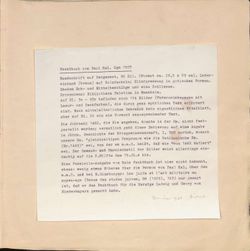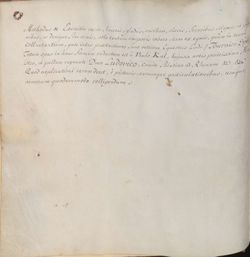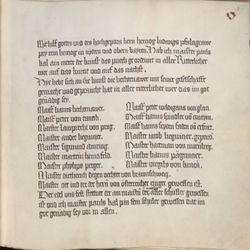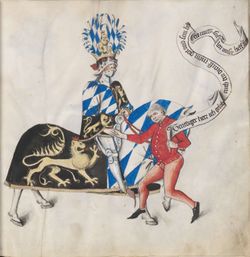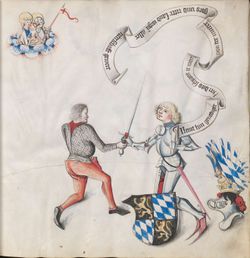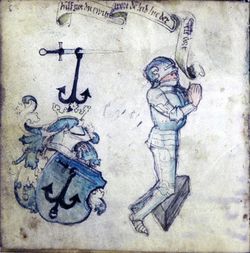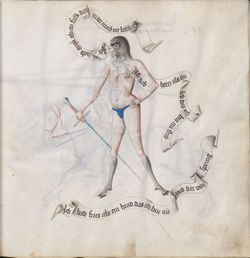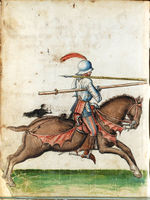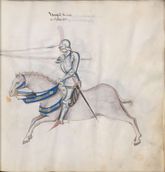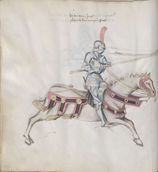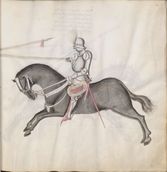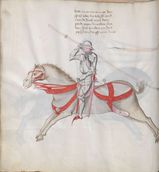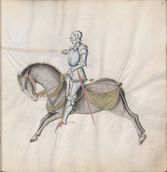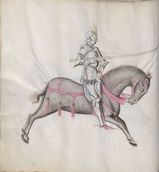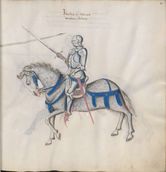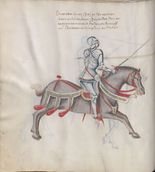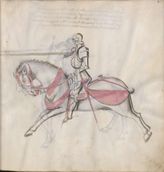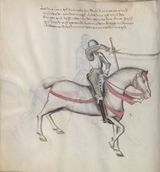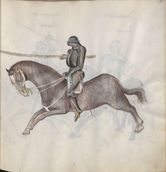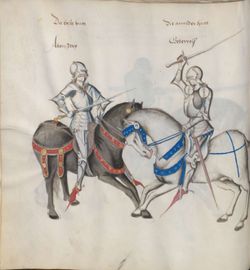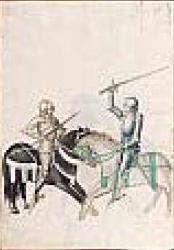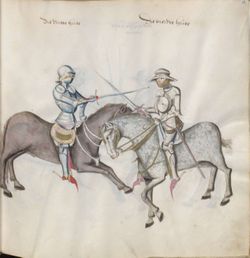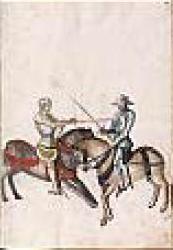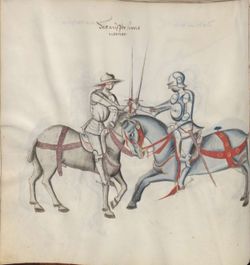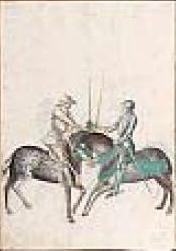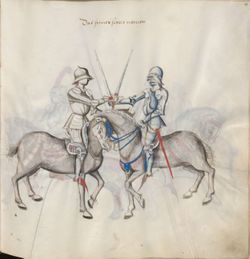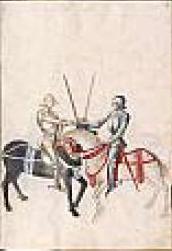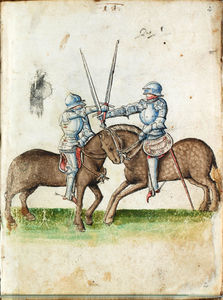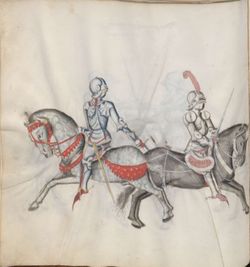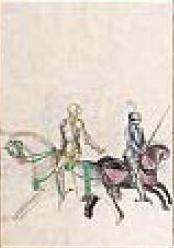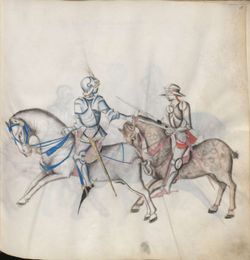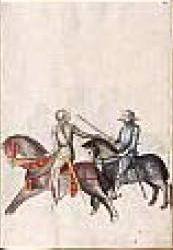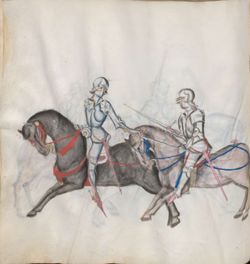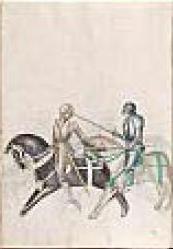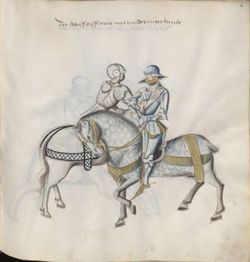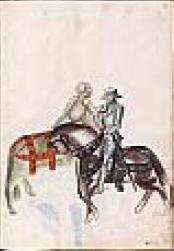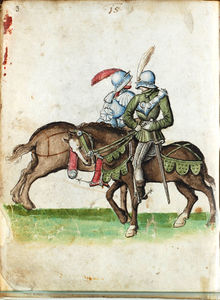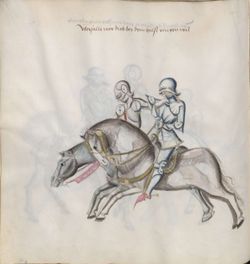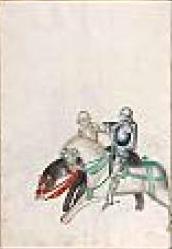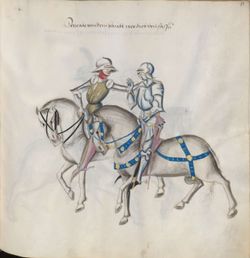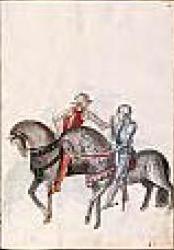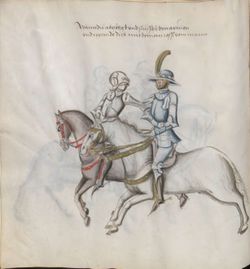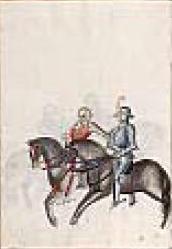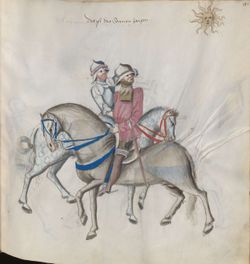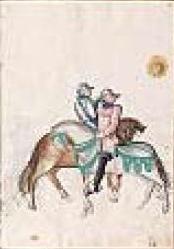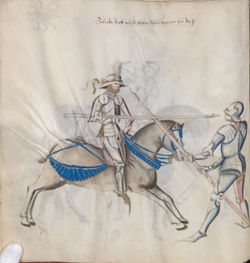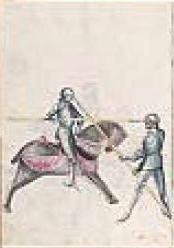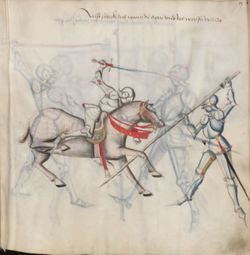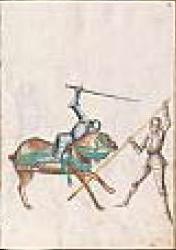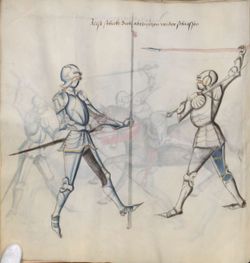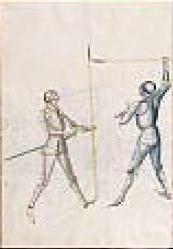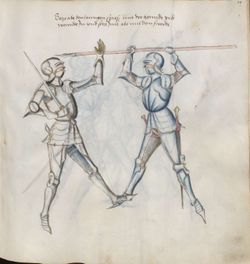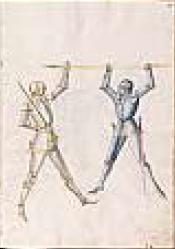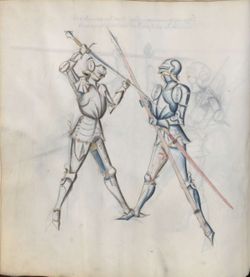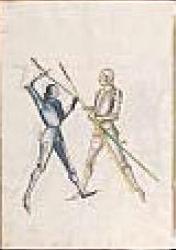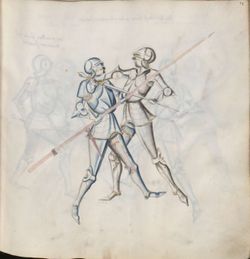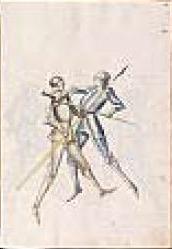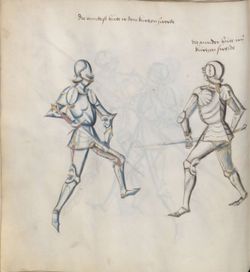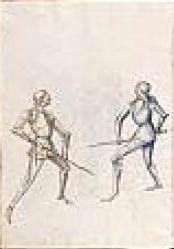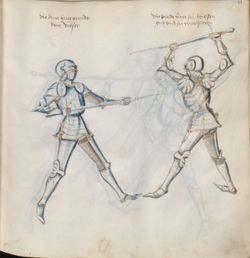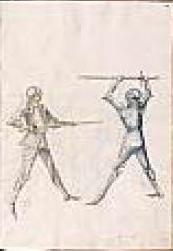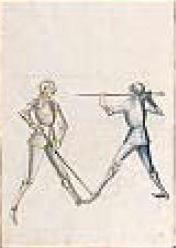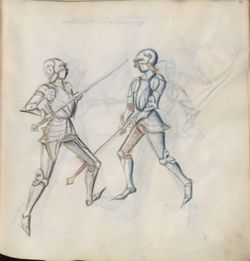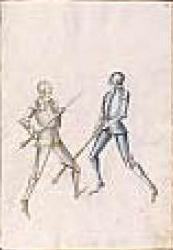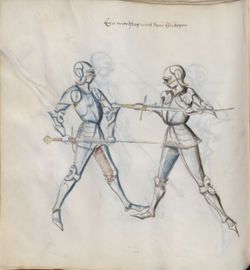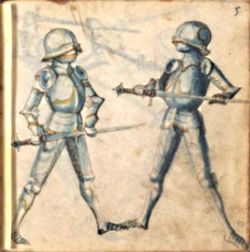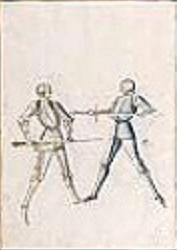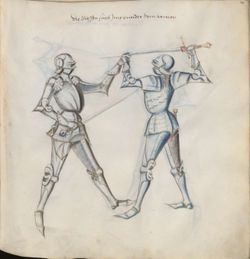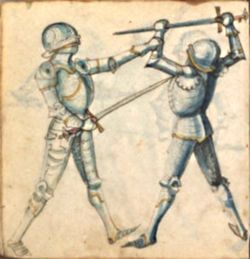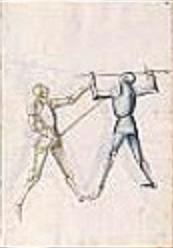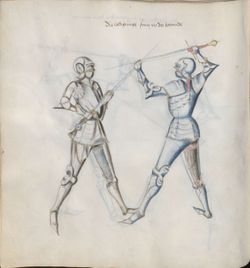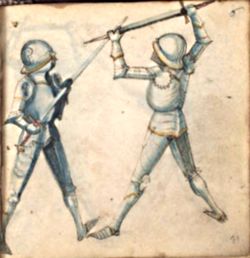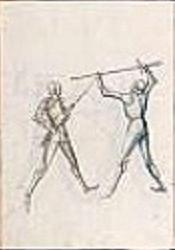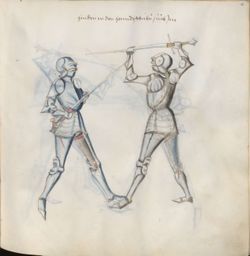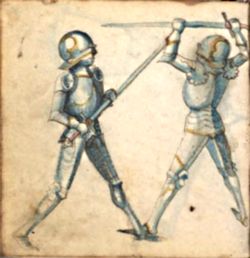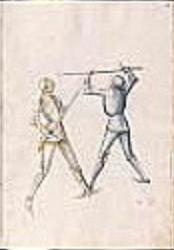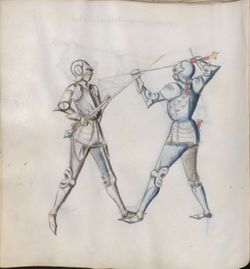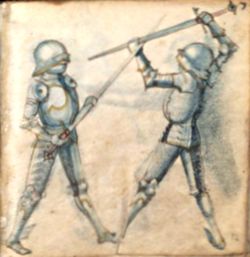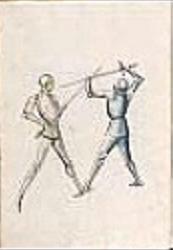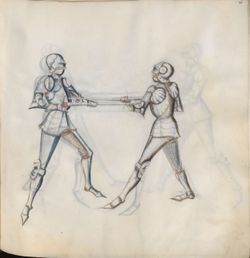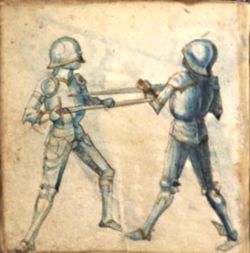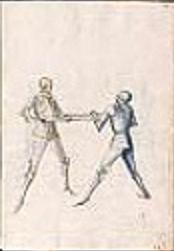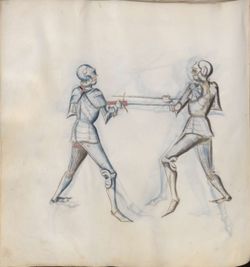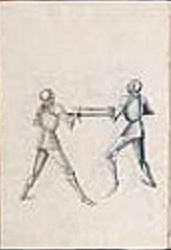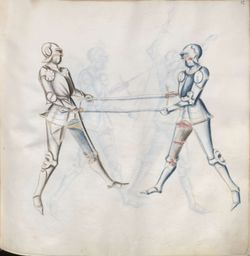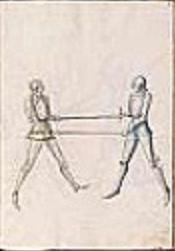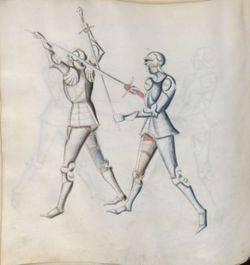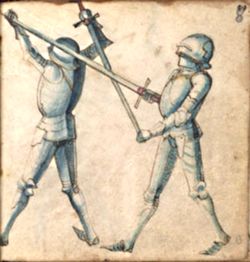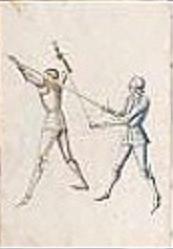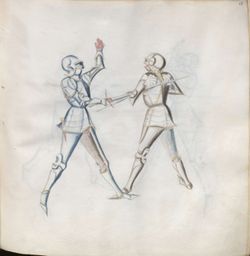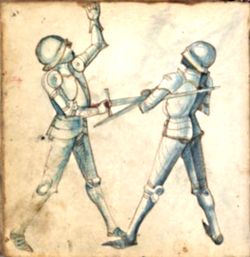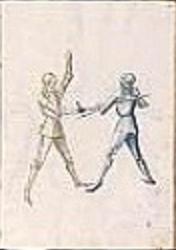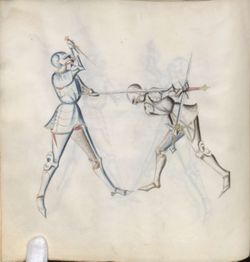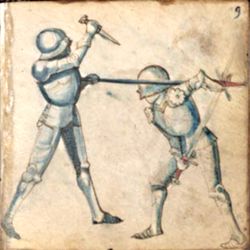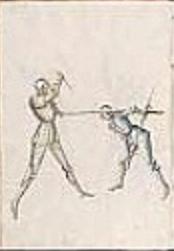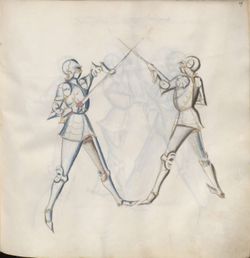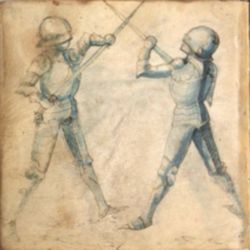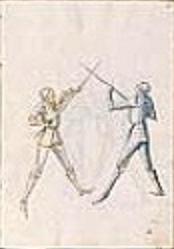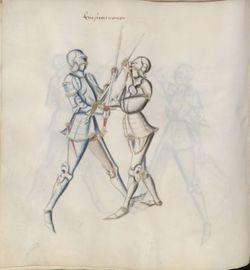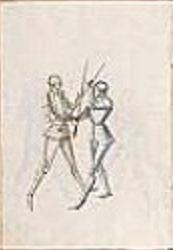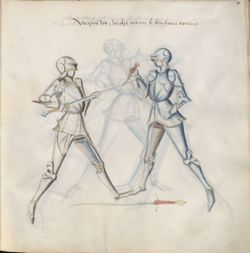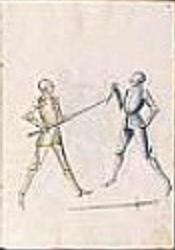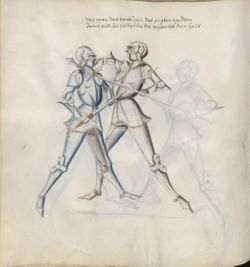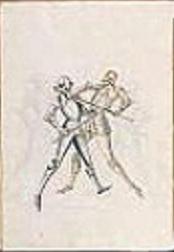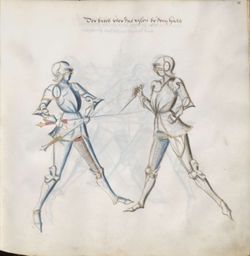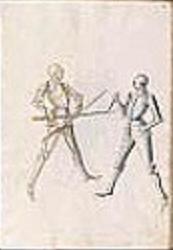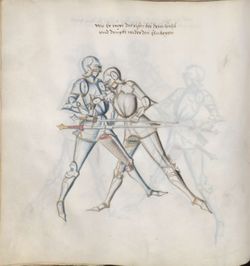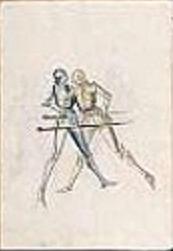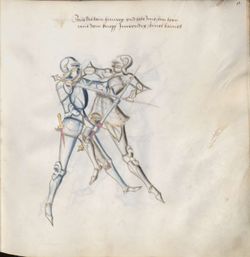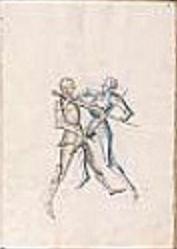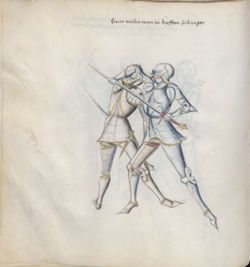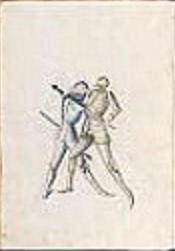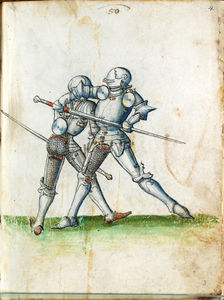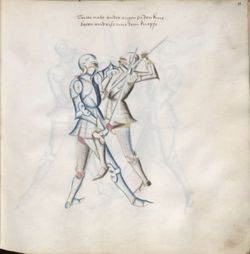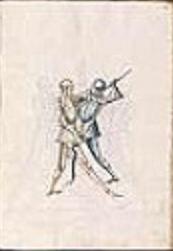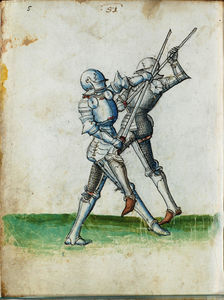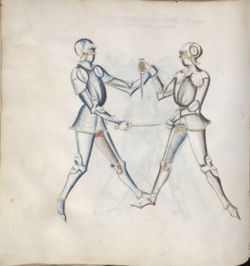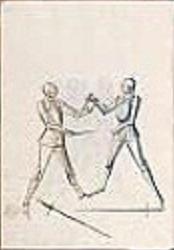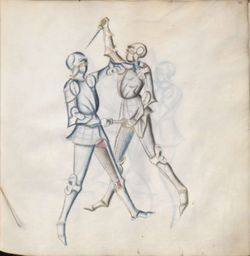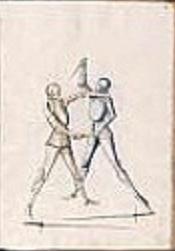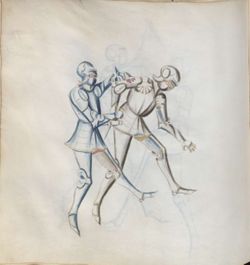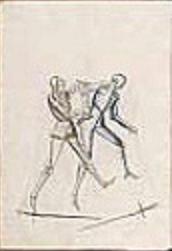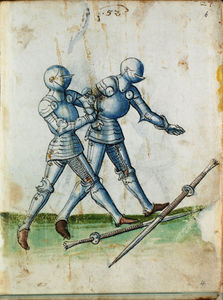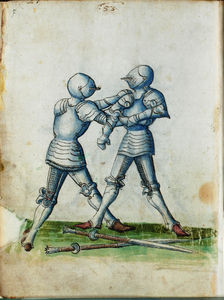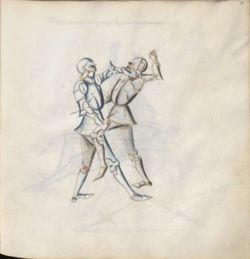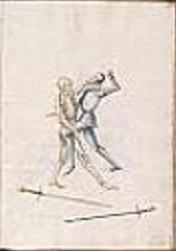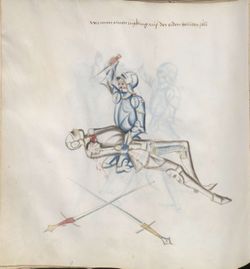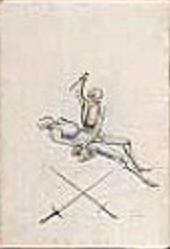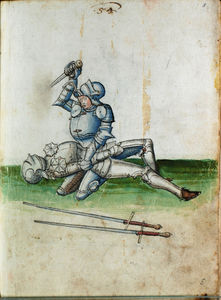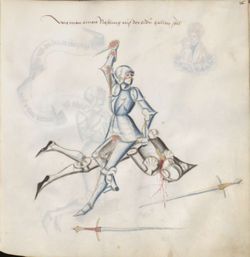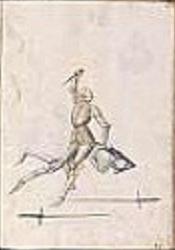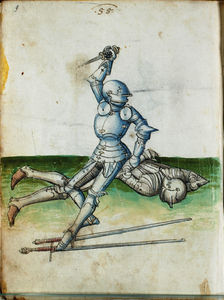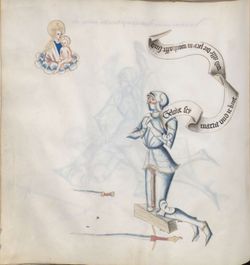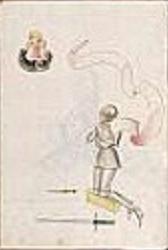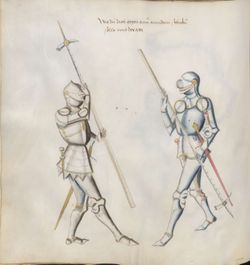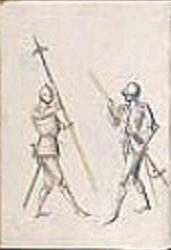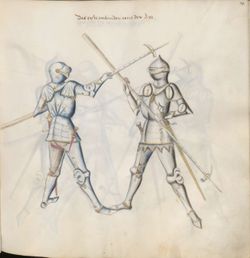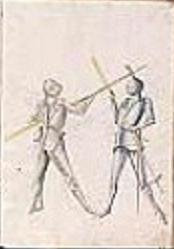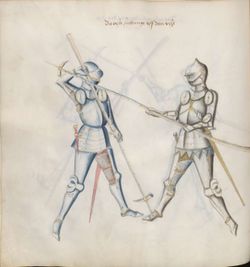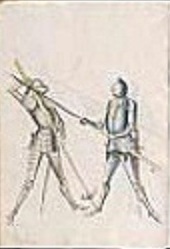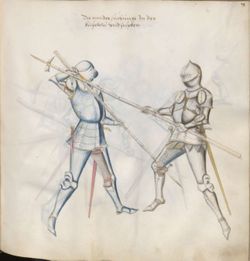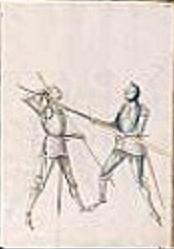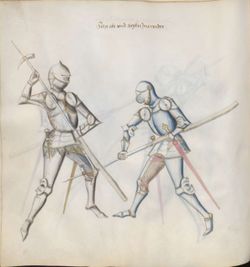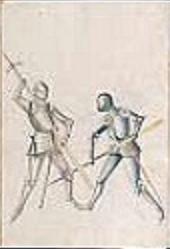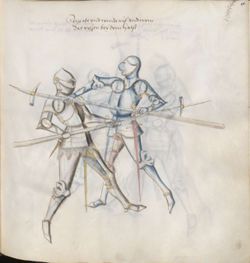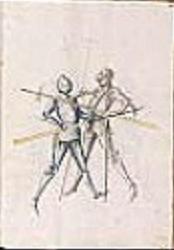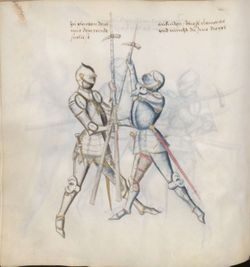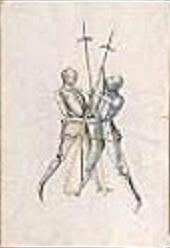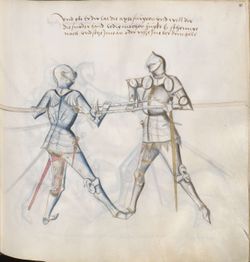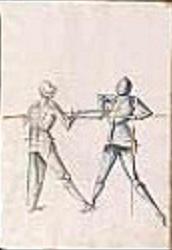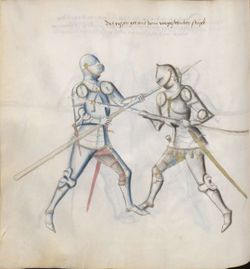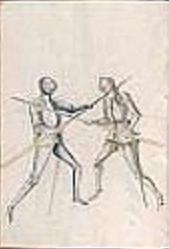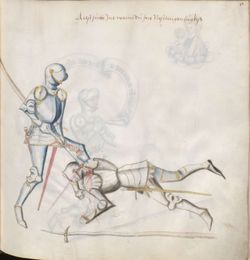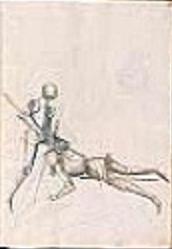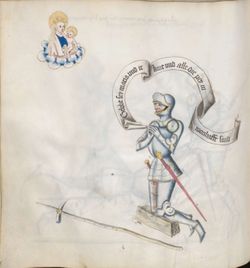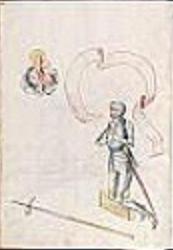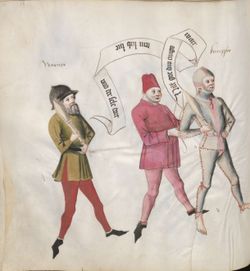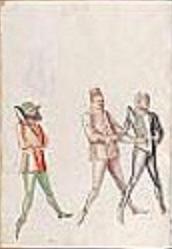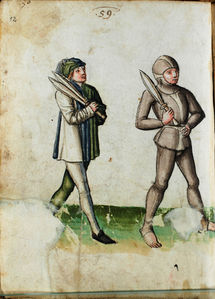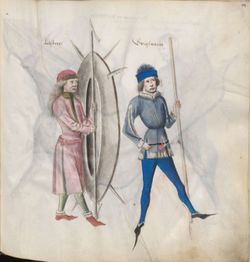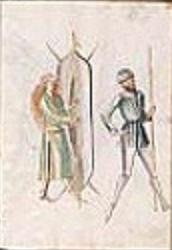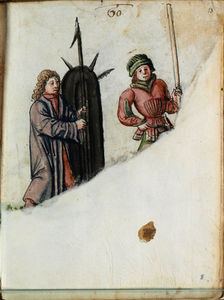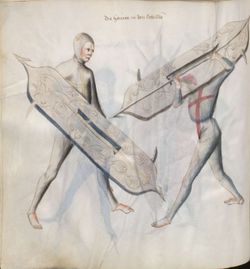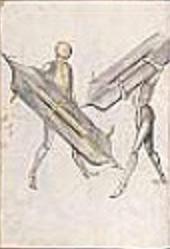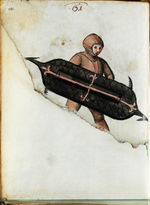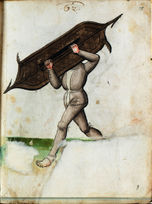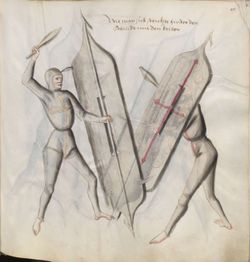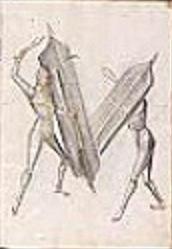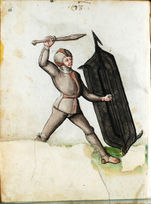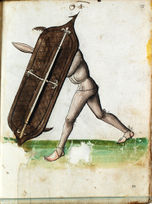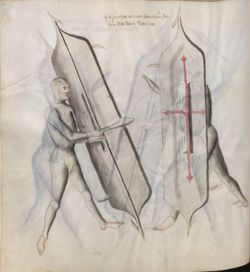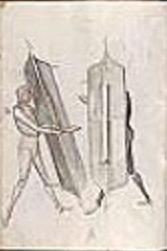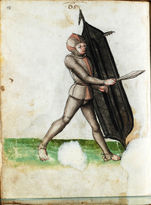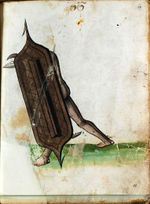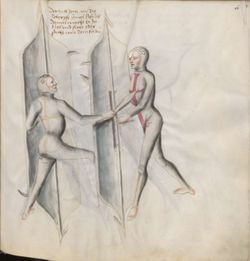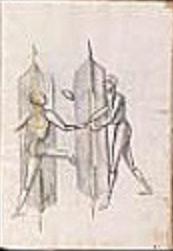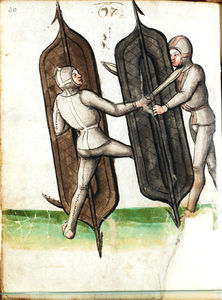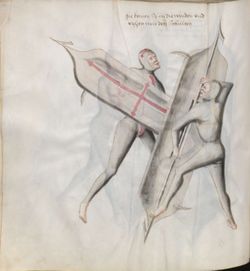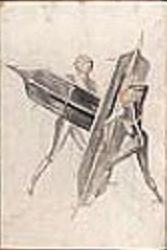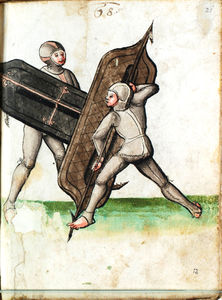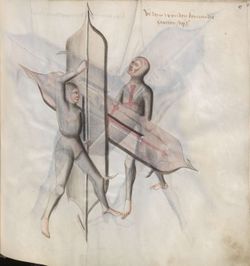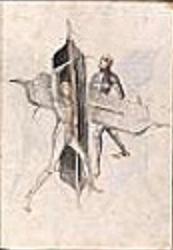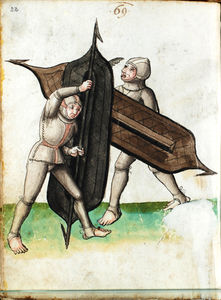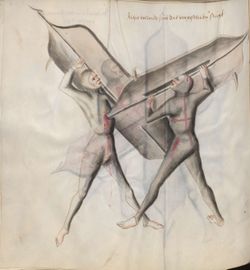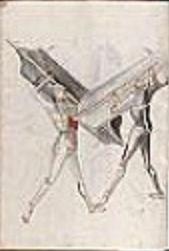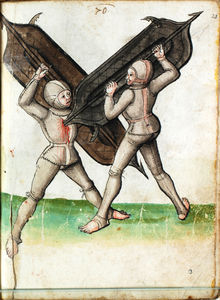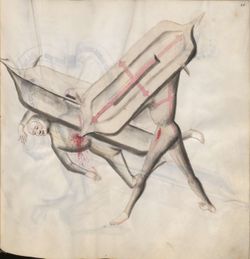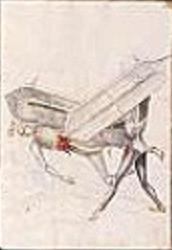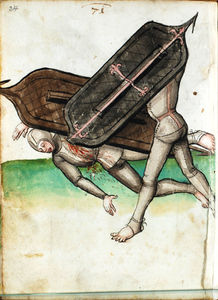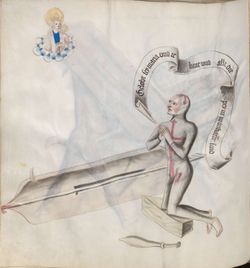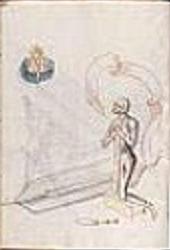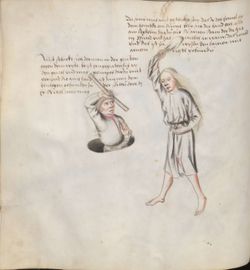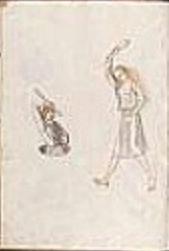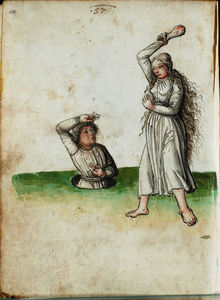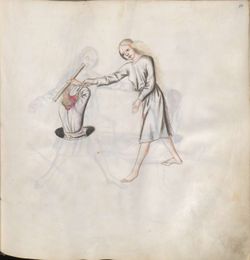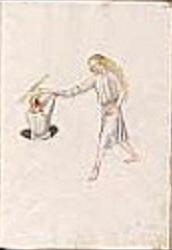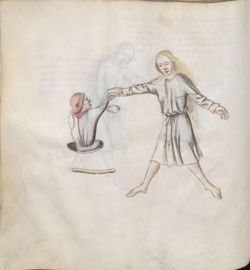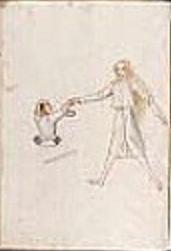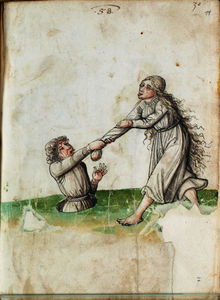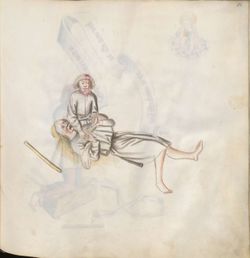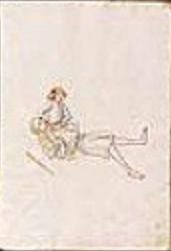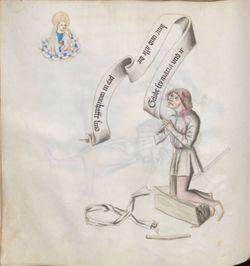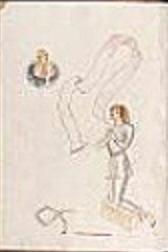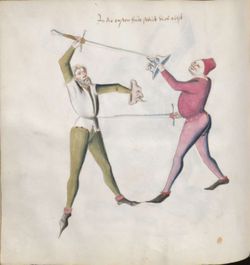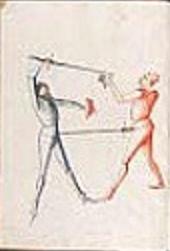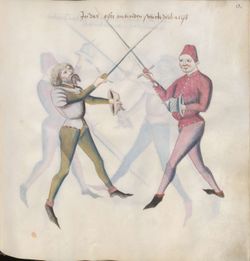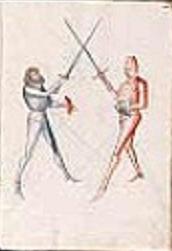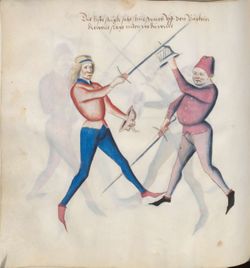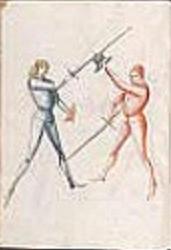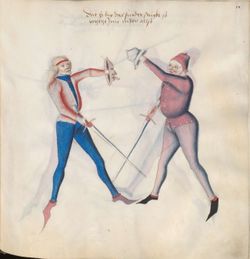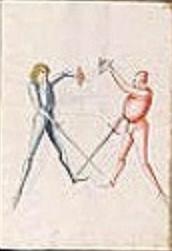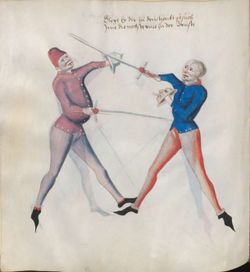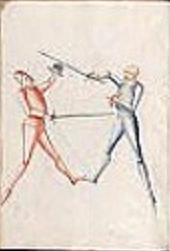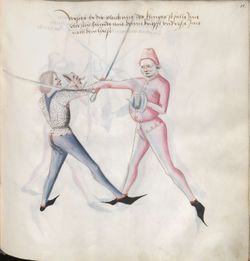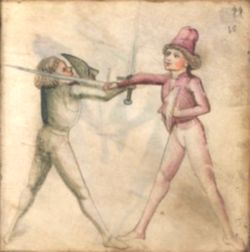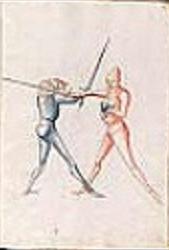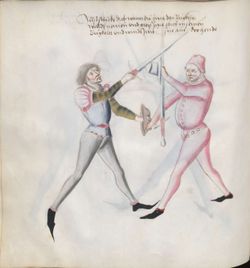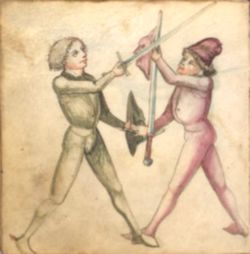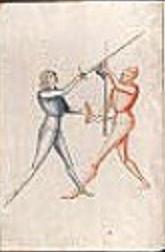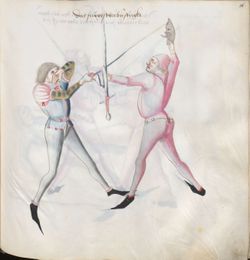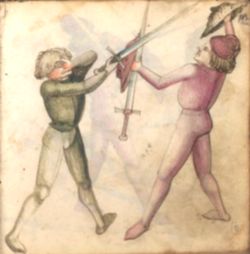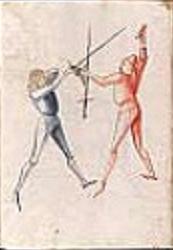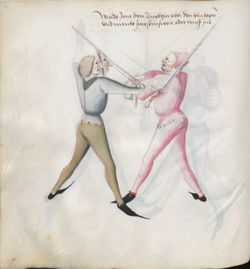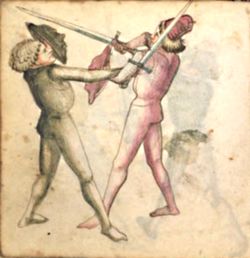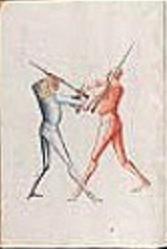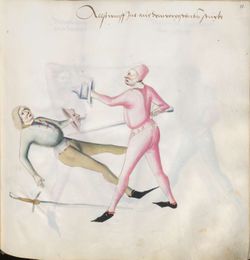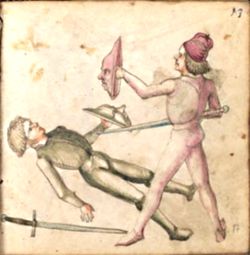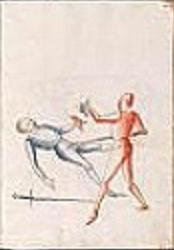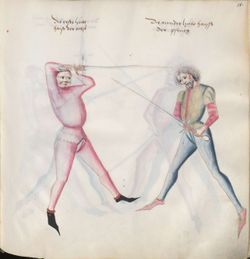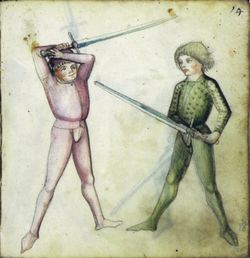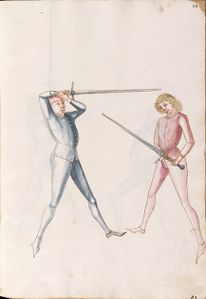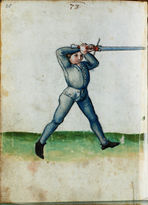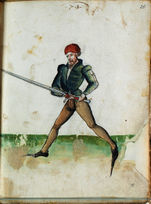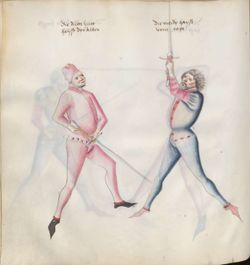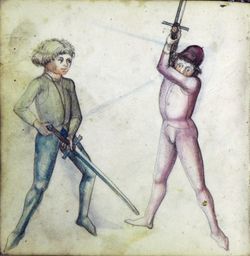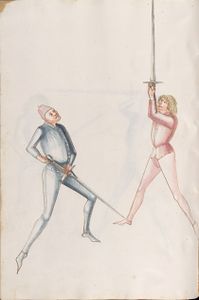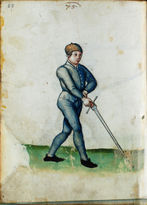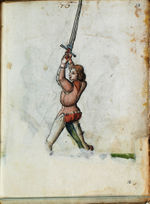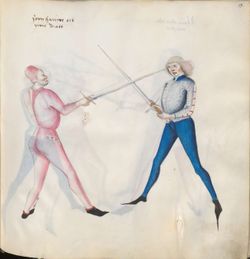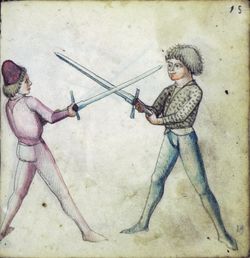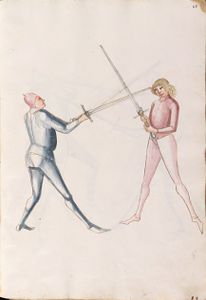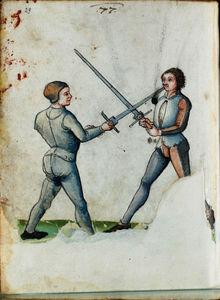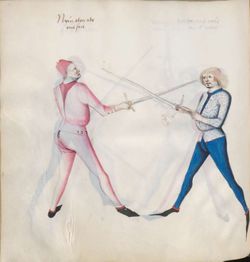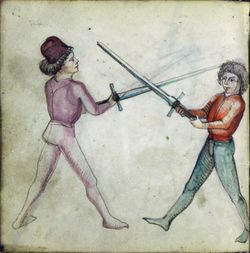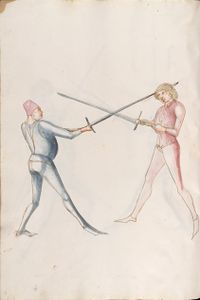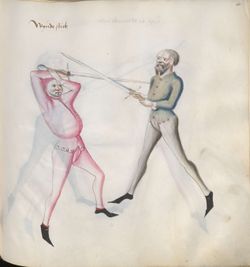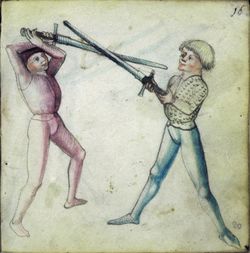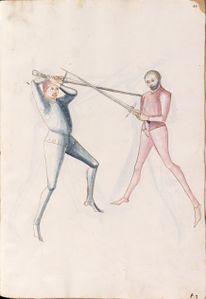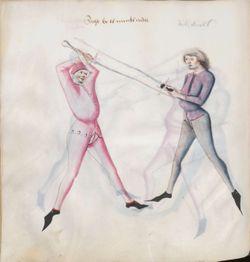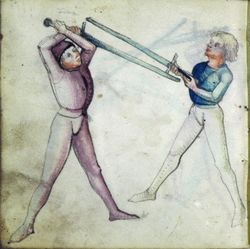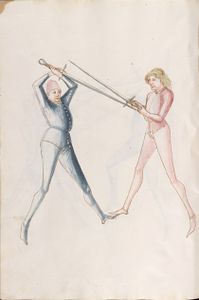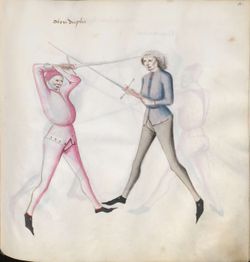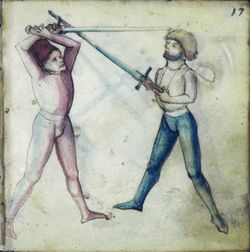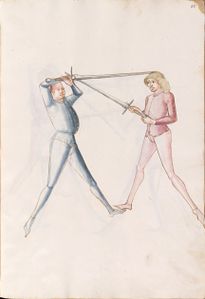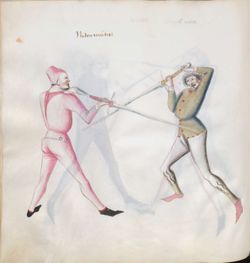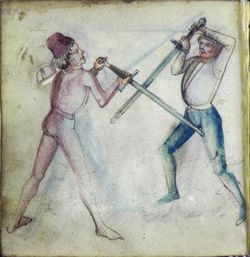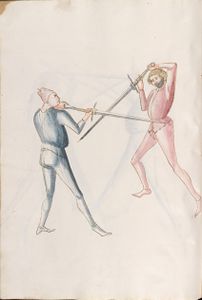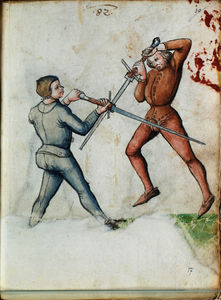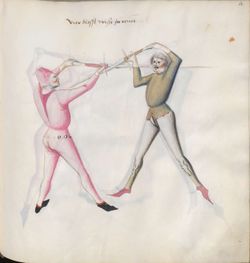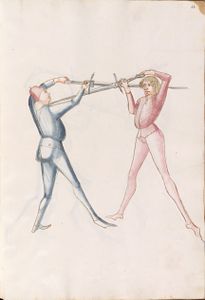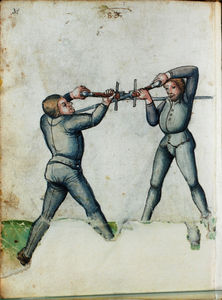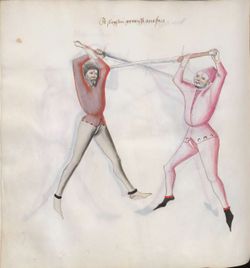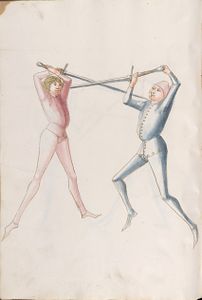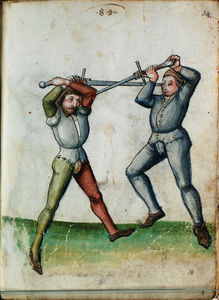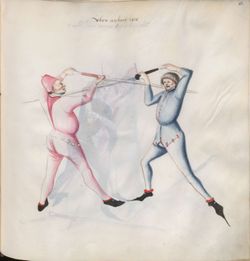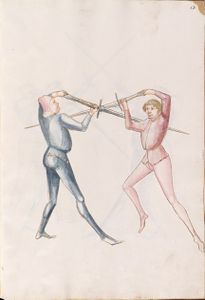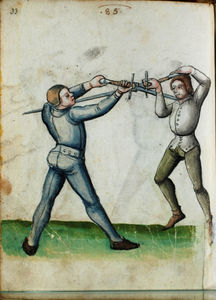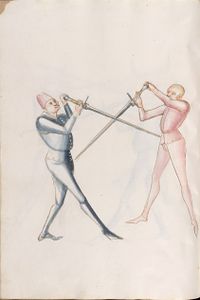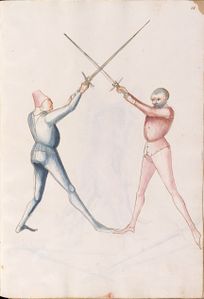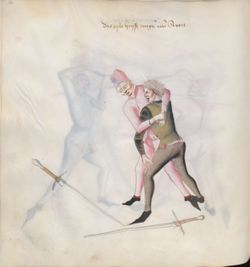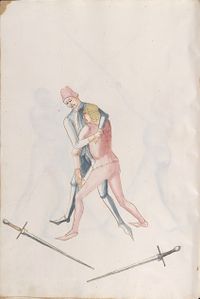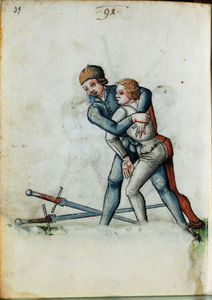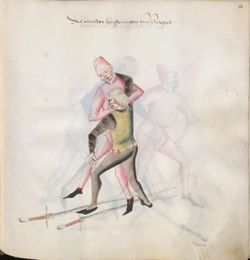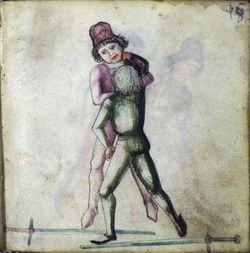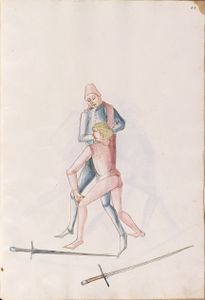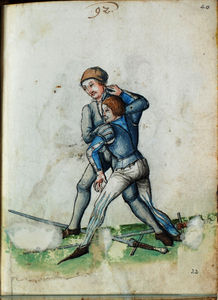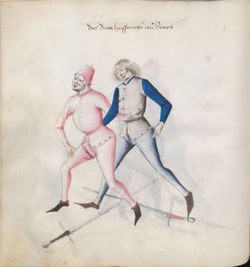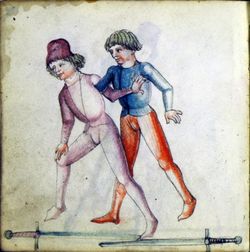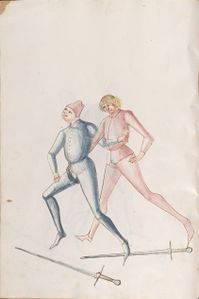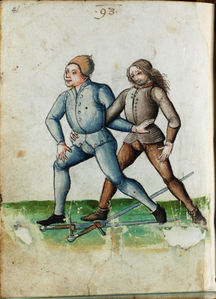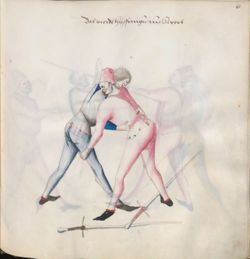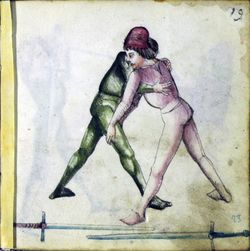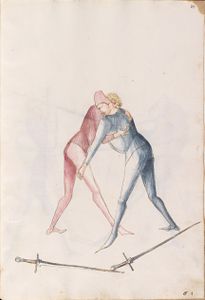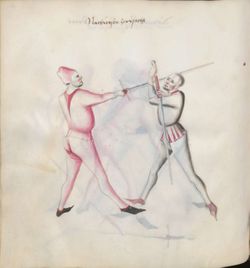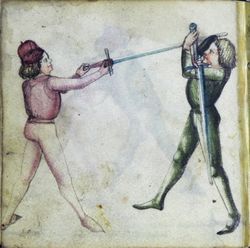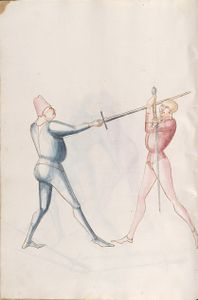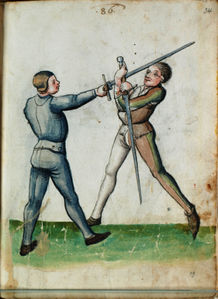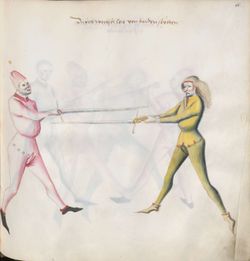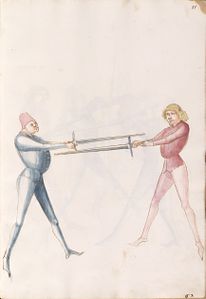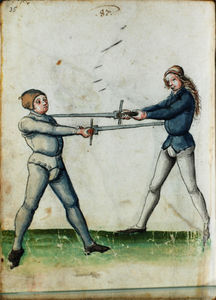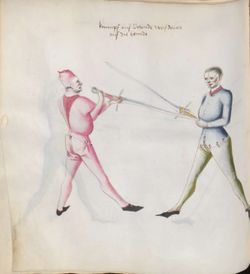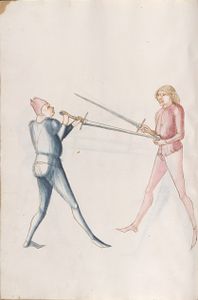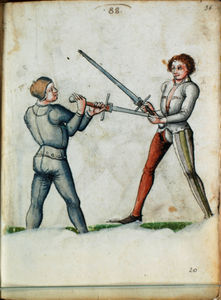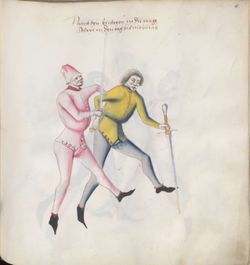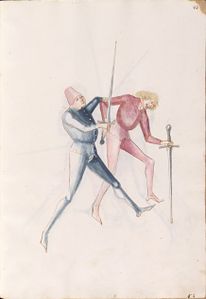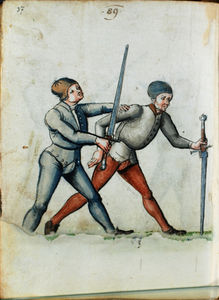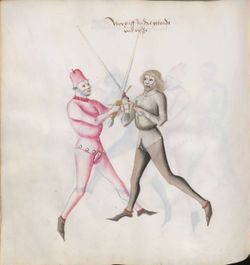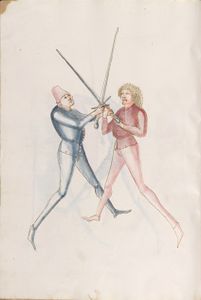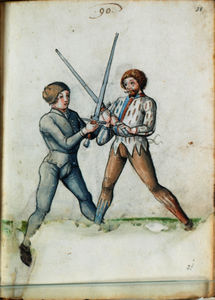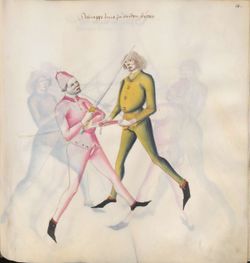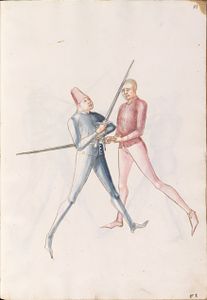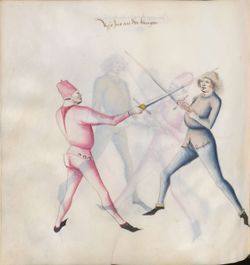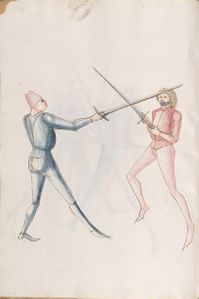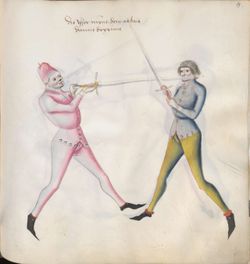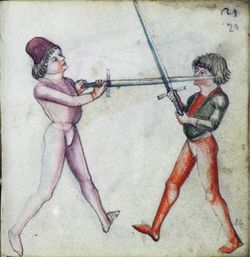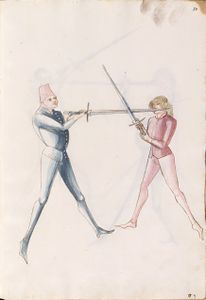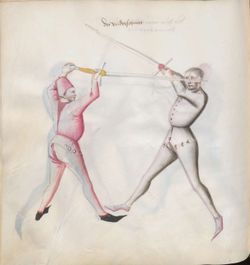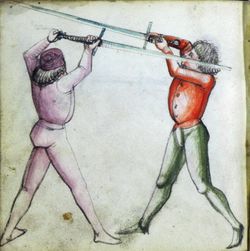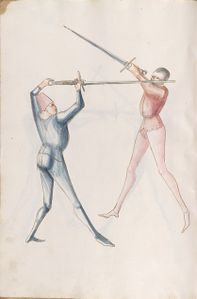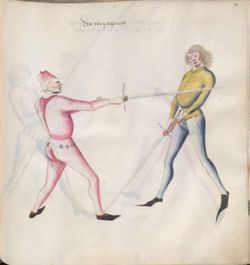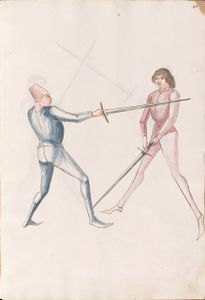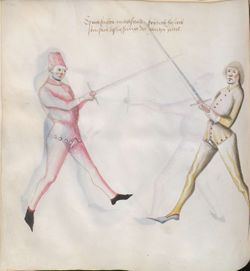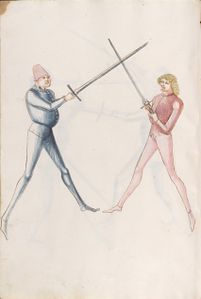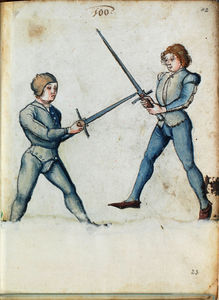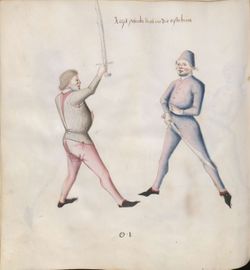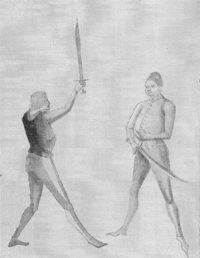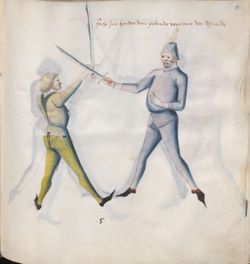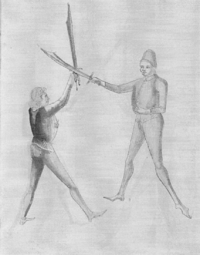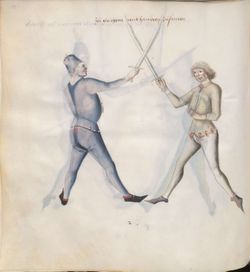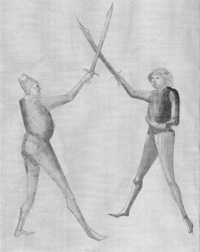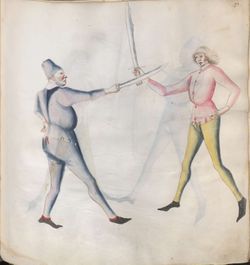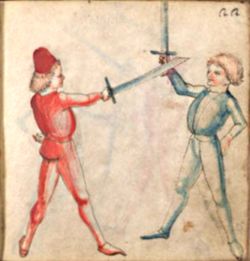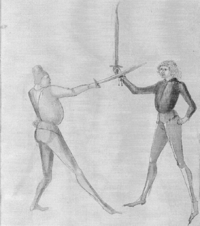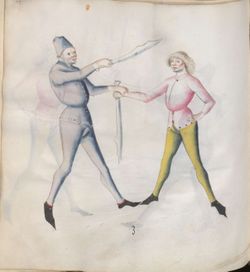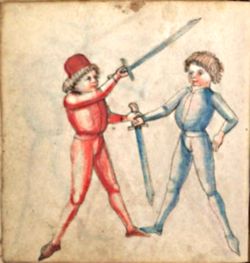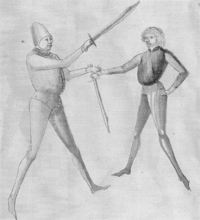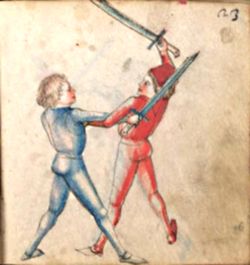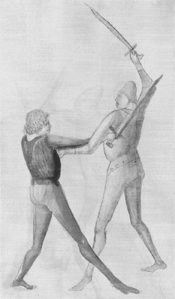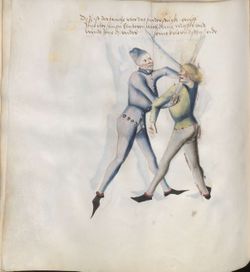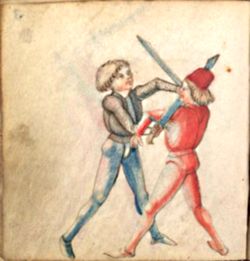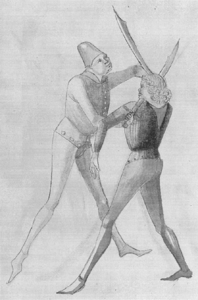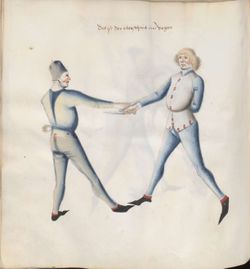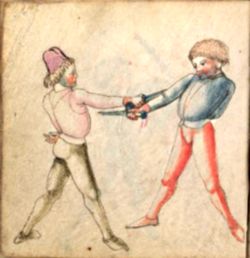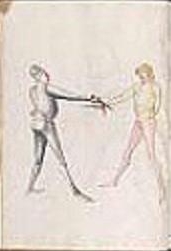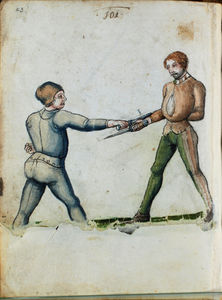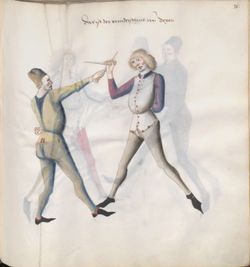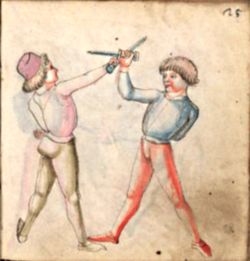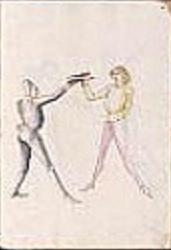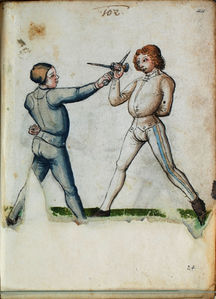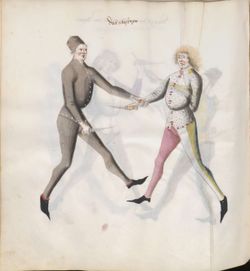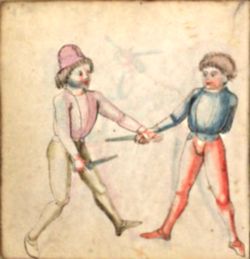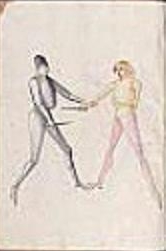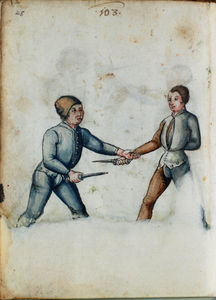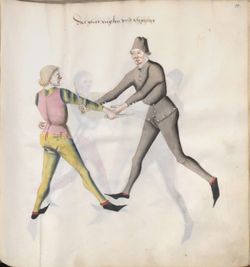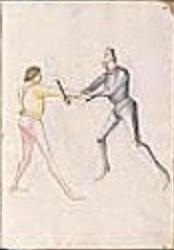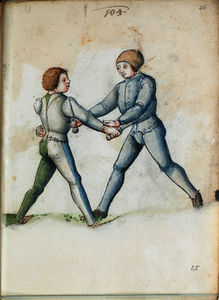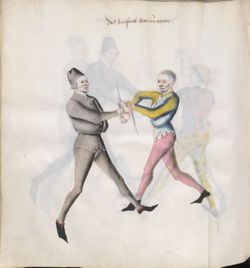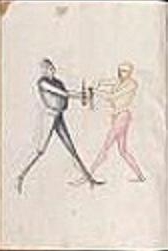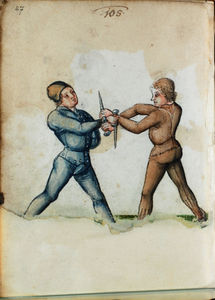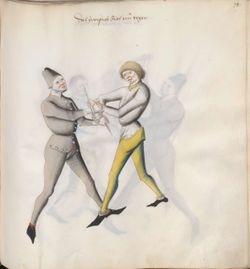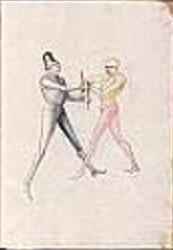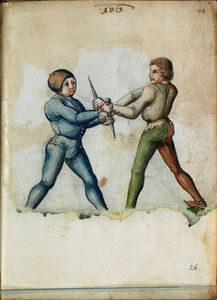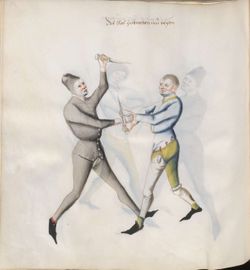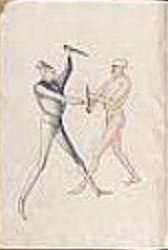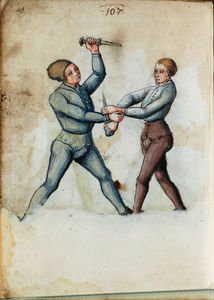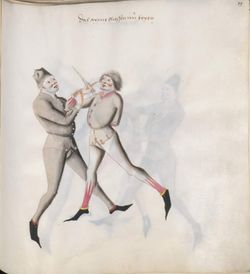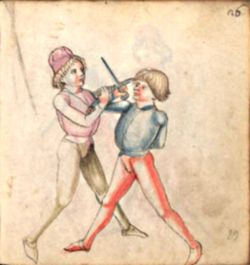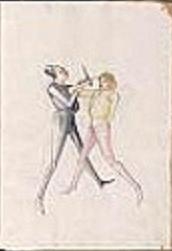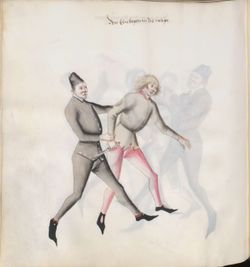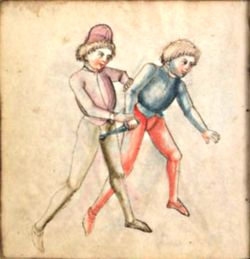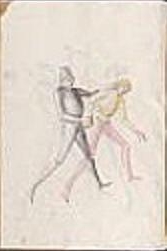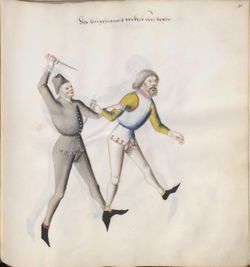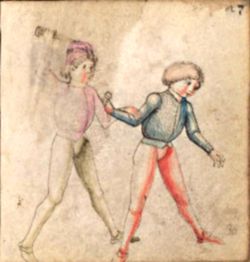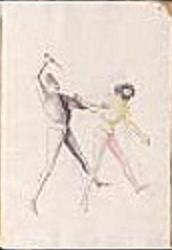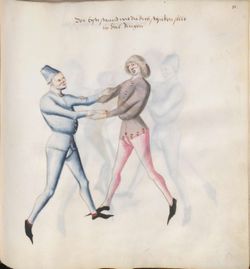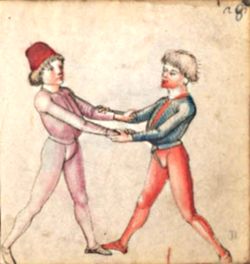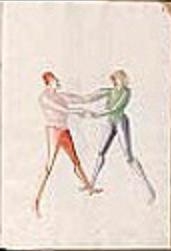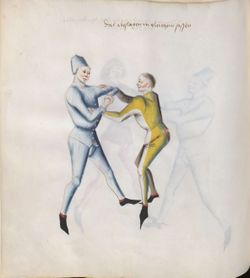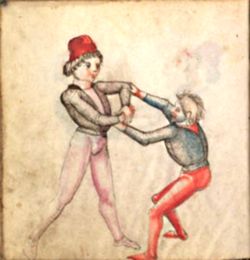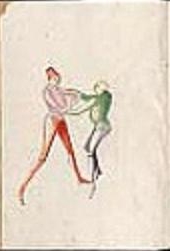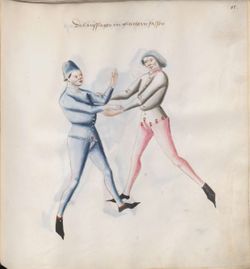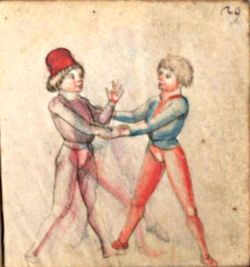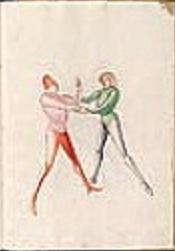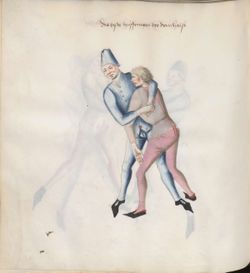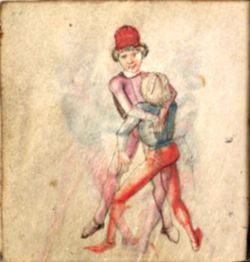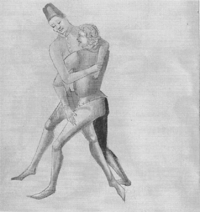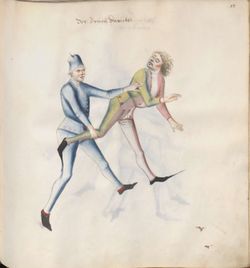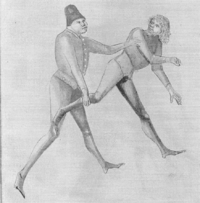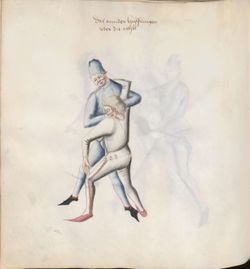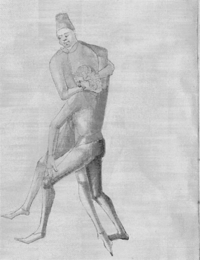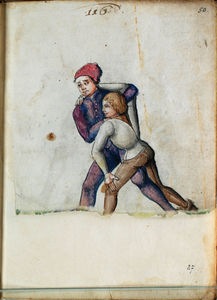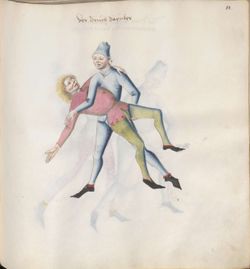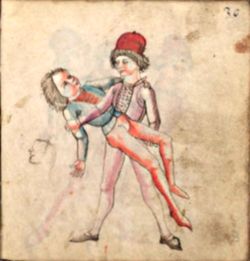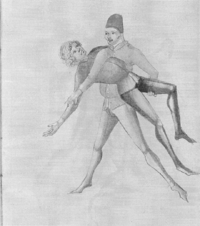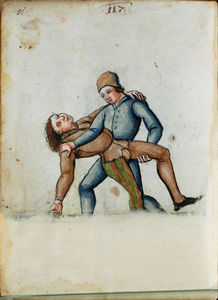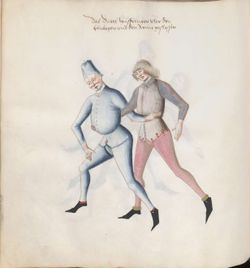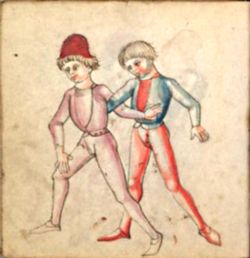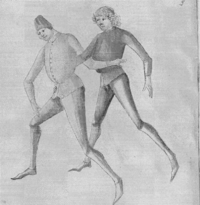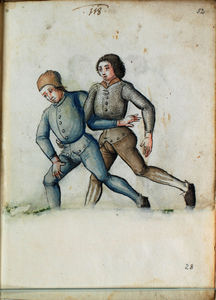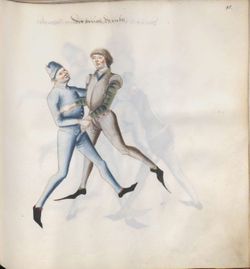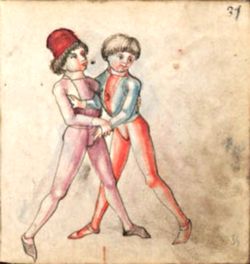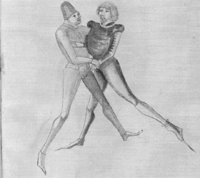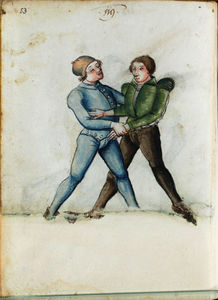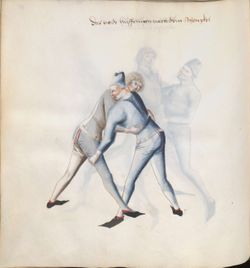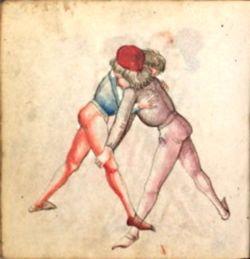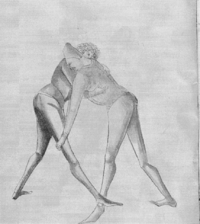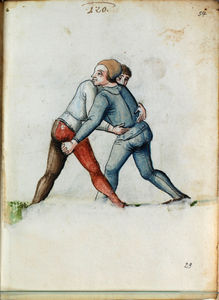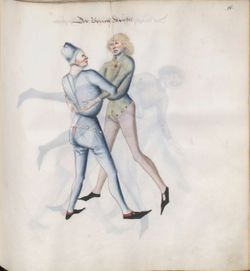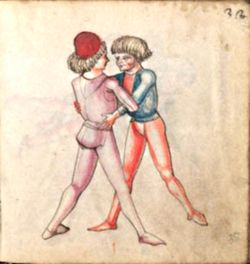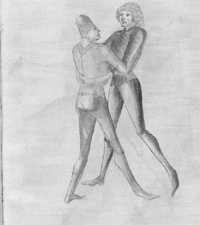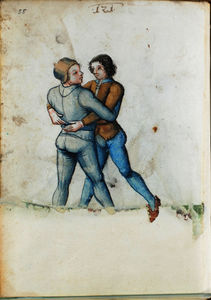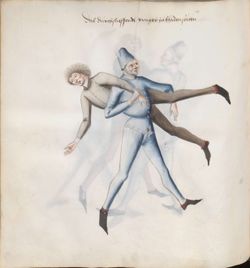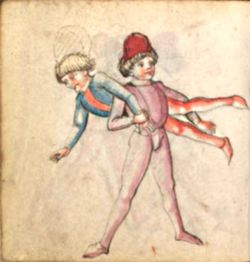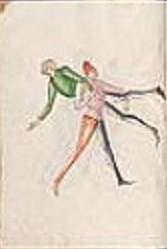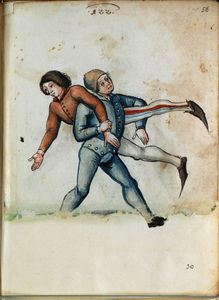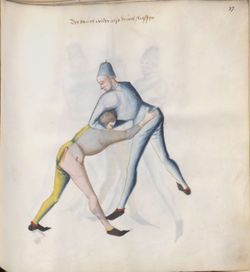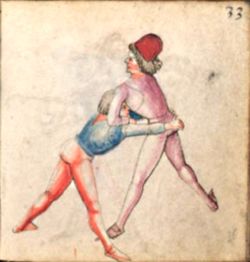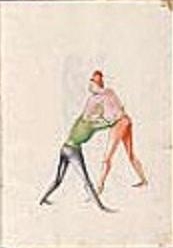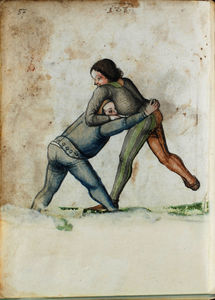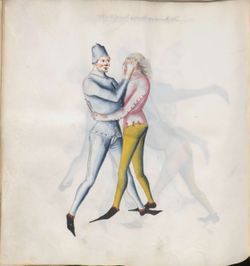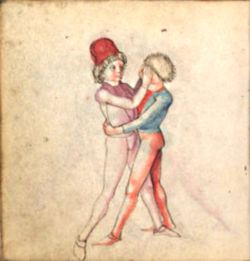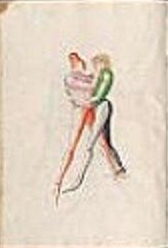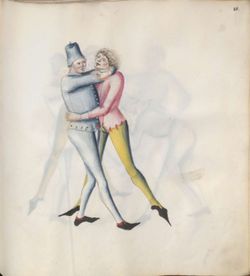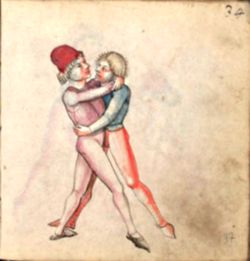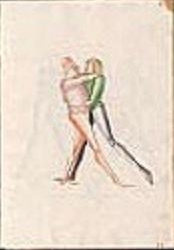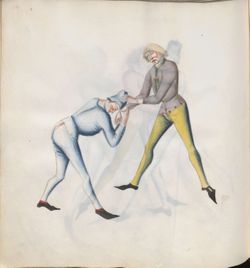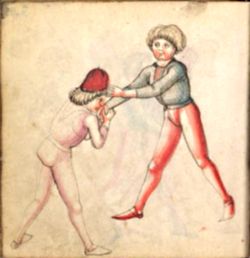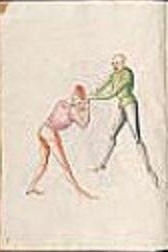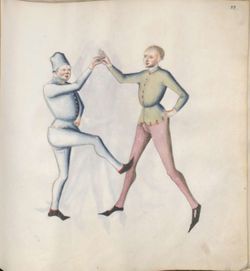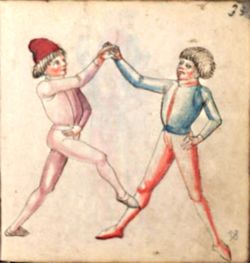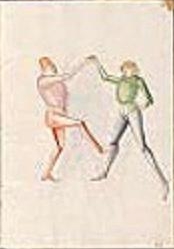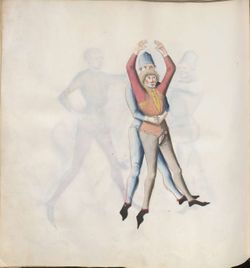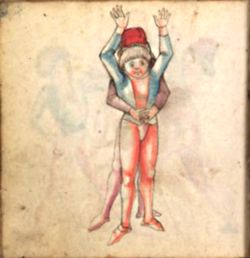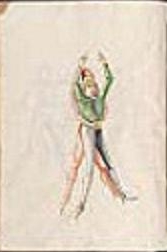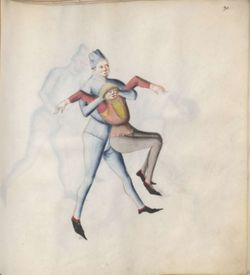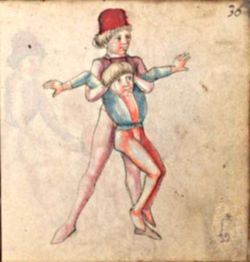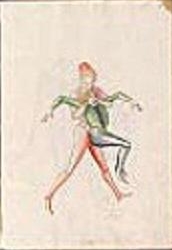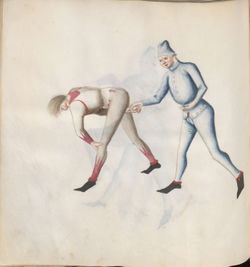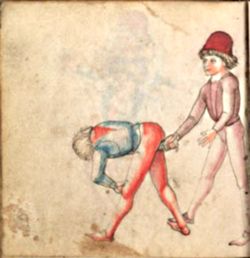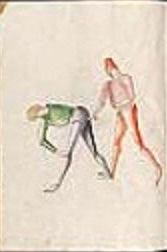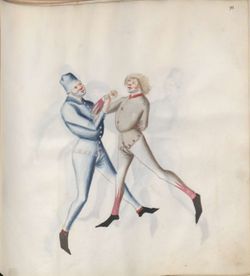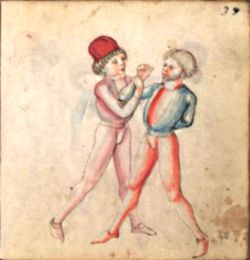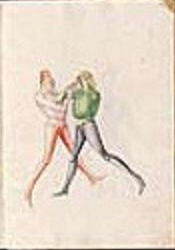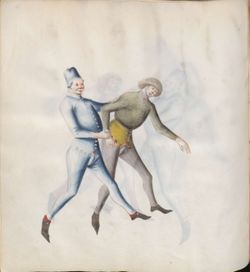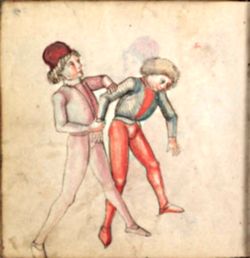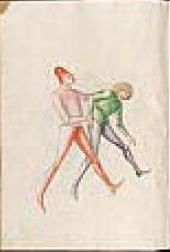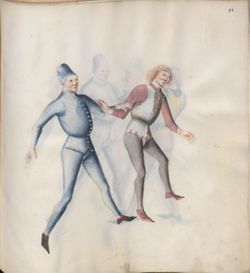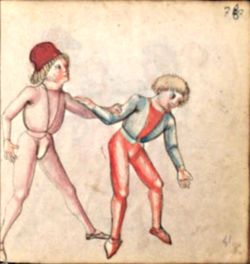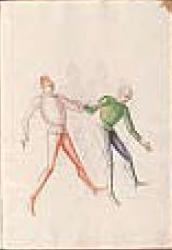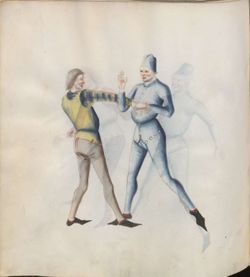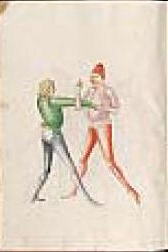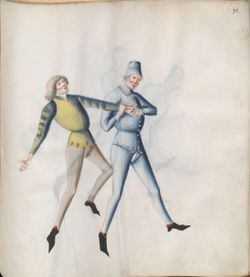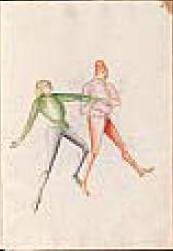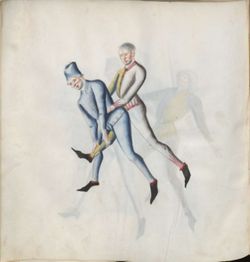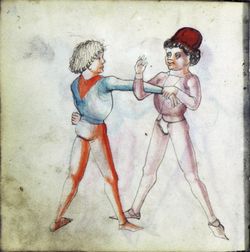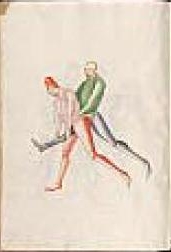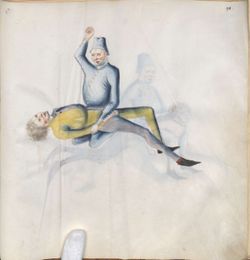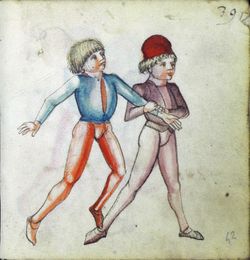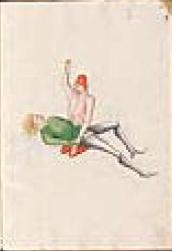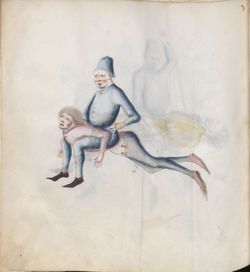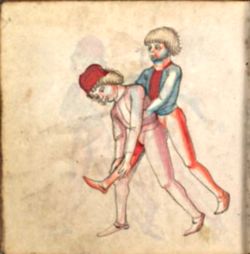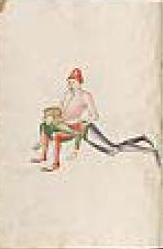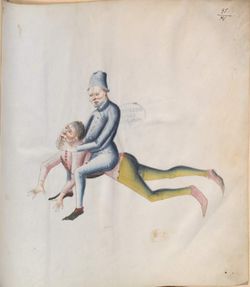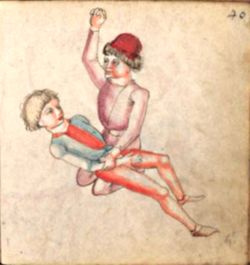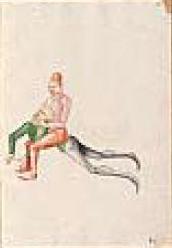|
|
You are not currently logged in. Are you accessing the unsecure (http) portal? Click here to switch to the secure portal. |
Paulus Kal
| Paulus Kal | |
|---|---|
 | |
| Born | ca.1420s Dingolfing, Germany |
| Died | after 1485 |
| Occupation |
|
| Patron |
|
| Movement | Society of Liechtenauer |
| Influences | |
| Influenced | Peter Falkner (?) |
| Genres | |
| Language | |
| Archetype(s) | |
| Manuscript(s) |
Gotti MS (late 1400s)
|
| First printed english edition |
Tobler, 2006 |
| Concordance by | Michael Chidester, Carsten Lorbeer, Julia Lorbeer, Andreas Meier, Marita Wiedner |
| Translations | |
Paulus Kal was a 15th century German fencing master. He wrote that he studied martial arts under Hans Stettner von Mörnsheim, and was an initiate of the tradition of Johannes Liechtenauer. He was also attached as Schirrmeister to three different courts in his career, serving in various military capacities including commanding men in at least three campaigns.[1] Perhaps his most significant legacy is an honor role of deceased masters[2] included in the Munich version of his fencing manual, which he styled the Society of Liechtenauer (Geselschaft Liechtenauers). While several of these masters remain unknown, the majority wrote treatises of their own and Kal's list stands as an independent confirmation of their connection to the grand master. Kal's treatise is interesting in that it represents the first attempt to illustrate Liechtenauer's Record (Zettel).
Little is known of Kal's early life, but from 1440 to ca. 1449 he served Ludwig IV "the Gentle" of the House of Wittelsbach, Count Palatine of the Rhine. In 1448, while in the count's service he participated in the defense Nuremberg, commanding a unit of wheel cannons below the gates.[3] The Nuremberg Council notes from 17 March 1449 mention that he had broken the peace of the city at that time by drawing his weapons.[4]
Kal entered the service of Ludwig IX "the Rich" of the House of Wittelsbach, Duke of Bavaria-Landshut, on 29 September 1450.[1] In 1461, he is mentioned commanding a unit of 12 marksmen.[citation needed] From 1465 to 1475, he seems to have also maintained a secondary occupation as a toll collector in Dingolfing.[5] In November 1468, he participated in military actions on the castle Saldenburg, which was successfully taken on 4 December.[6] Shortley thereafter, in ca. 1470, Paulus Kal created a second, expanded version of his fencing manual for Ludwig IX, the current Cgm 1507 (as well, possibly, as the MS 1825). Kal is listed as a guest at the wedding of Ludwig's son George,[7] and continued in the duke's service until his death on 18 January 1479.
On 12 February 1480, Paulus Kal entered the service of Sigismund of the House of Habsburg, Archduke of Austria and Tyrol.[1] Kal acted as one of the archduke's witnesses at a number of interrogations held on 17 October 1485 in Innsbruck, related to the witch trials being conducted by Heinrich Kramer at that time.[8] This is the final time that Kal's name appears in the histories. Several copies of Kal's treatise were created during the 1480s and 90s, including the extensive MS KK5126, but it is unknown if he directly commissioned any of them.
In total, Paulus Kal's teachings are preserved in at least six manuscripts written between 1440 and 1514. The probable archetype, Cgm 1507, includes brief explanations in German for most devices (many extracted from Liechtenauer's record). There are four other text-less versions, and these were probably copied from the 1470 version. A sixth version was sold at auction in Italy during the 20th century as individual leaves; this copy contains single-word captions in Latin or Italian and was likely based on one of the four without text. In addition, Paulus Hector Mair based content in several sections of the Munich version of his Opus Amplissimum de Arte Athletica on Kal's treatise. It appears that the copy he used for this was textless, and so he added his own extensive commentary on the images. The precise set of images Mair drew upon do not appear in any of the six extant manuscripts, which may signify that there was once a seventh copy of Kal's work which has since been lost.
Contents
Treatise
| Images | Draft Translation Open for editing |
Munich Version (ca. 1470) | Bologna Version (1458-1467)
Carsten Lorbeer, Julia Lorbeer, Andreas Meier, Marita Wiedner |
Vienna Version (ca. 1480s) | Gotha Version (ca. 1473-1503) | Solothurn Version (ca. 1506-1514)
|
|---|---|---|---|---|---|---|
[Ir] Fechtbuch von Paul Kal, Cgm 1507 Handschrift auf Pergament, 95 Bll. (Format ca. 28,5 x 29 cm). Ledereinband (braun) auf Holzdeckeln; Blindpressung in gotischen Formen. Ehedem Eck- und Mittelbeschläge und eine Schliesse. Provenienz: Bibliotheca Palatina in Mannheim. Auf Bl. 3v - 93r befinden sich 174 Bilder (Federzeichnungen mit Lasur- und Deckfarben), die durch ganz spärlichen Text erläutert sind. Nach mittelalterlichem Gebrauch kein eigentliches Titelblatt, aber auf Bl. 2r ein als Vorwort anzusprechender Text. Die Jährzahl 1462, die Sie angeben, konnte in der Hs. nicht festgestellt werden; vermutlich geht diese Datierung auf eine Angabe in Jähns, Geschichte der Kriegswissenschaft, I, 368 zurück, wonach unsere Hs. "gleichzeitigen Ursprungs wie die Vatikanische Hs. (Nr.1449)" aei, von der es a.a.0. heißt, daß sie "von 1462 datiert" sei. Der Gewand- und Harnischstil der Bilder weist allerdings eindeutig auf die 2.Hälfte des 15.Jh.s hin. Eine Faksimile-Ausgabe von Kals Fechtbuch ist hier nicht bekannt, ebenso wenig etwas Näheres über die Person von Paul Kal, über den a.a.0. und bei M.Ginsburger: Les juifs et l'art militaire au moyen-age (Revue des etudes juives, 88 (1929), 163) nur gesagt ist, daß er das Fechtbuch für die Herzöge Ludwig und Georg von Niederbayern gemacht habe. |
||||||
[01v] Methodus & Exercitia varia, lanceis, gladiis, ensibus, clavis, Securibus, clypeis et pug nibus, ac denique Sine armis, solo tantum corporis robore, tam ex equis, quam in terra colluctantium, quos inter prastantiores Sunt veterum Equestres Ludi. / Tournier Spiel / Totum opus in hanc formam redactum est à Paulo Kal, hujusce artis peritissimo Magistro, et quidem regnante Duce Ludovico, comite Palatino ad Rhenum etc etc Quod explicationi rerum deest, è picturis, earúmque gesticulationibus, usúque armorum quodammodo colligendum. |
||||||
|
With the help of God and of the highborn lord Duke Ludwig, Count Palatine of the Rhine in Lower and Upper Bavaria, I, Master Paulus Kal, an exponent of art, have made this book, which deals with all knightly weapons in brief succession.
Master Johannes Liechtenauer. Master Dietrich Degenfechter von Braunschweig. The noble and zealous Hans Stettner von Mörnsheim, which is most of all the master of all pupils—and I, Master Paulus Kal, was his student—may God have mercy on him above all of them. |
[02r] Mit hilf gottes und des hochgeporn hern herczog ludwigs pfalczgrawe peÿ rein herczog in nydern und obern bayren. Hab ich maister pauls kal ain merer der kunst das püech geordenirt in aller Ritterlicher wer auf das kurczt und auf das nachst. Hye hebt sich an die kunst die liechtenawer mit seiner geselschafft gemacht und gepraücht hat in aller ritterliche wer das im got genädig seÿ. Maister hanns liechtenawer.Maister peter wildigans von glacz. Maister peter von tanczk. Maister hanns spindler von czuaÿm. Maister lamprecht von prag. Maister hanns seÿdenfaden von erfürt. Maister andre liegniczer. Maister iacob liegniczer, geprieder. Maister sigmund amring. Maister hartman von nurenberg. Maister martein hunczfeld. Maister hanns pägnnczer. Maister phÿlips perger. Maister virgilÿ von kracå. Maister dietherich degen vechter von brawnschweig. Maister ott iud der der heren von oesterreicher ringer gewessen ist. Der edel vnd fest stettner der am maisten der maister aller schüller gewessen ist vnd ich maister pauls kal pin sein schuler gewessen dat im got genädig seÿ vor in allen. |
|||||
My Lord, I vow to serve you. My God and his dear mother to be our help. |
[04r] Genediger herr ich gelob euch den dienst mein gott und sein lieb ein muter sullen unser helfer sein |
|||||
Take the sword, my lord, you will be protected by the Mother of God and the chivalrous knight, St. George. |
[05r] Nemt hin genediger herr das schwert ir wert von der muter gots und riter sand iorgen aller riterschafft gewert |
|||||
[05v] hilf got du ewig wort dem leib hie der Sele dort |
||||||
|
I have eyes like a hawk, so you do not deceive me.
|
[06r] Ich hab augen als ein falk das man mich nit beschalk
|
[06r] ich hab augen als ein valk · das man mich nit beschalk ·
|
[10r] |
| Images
from the Munich Version |
Draft Translation Open for editing |
Munich Version (ca. 1470) | Images
from the Bologna Version (1458-1467) |
Images
from the Vienna Version (ca. 1480s) |
Images
from the Gotha Version (ca. 1473-1503) |
Images
from the Solothurn Version (ca. 1506-1514) | ||
|---|---|---|---|---|---|---|---|---|
Your spear extends very far.
|
[6v] Sine spere beriecht nach dem lengsten
|
[6v]
|
[10v]
|
[3v]
|
[N.1] | |||
| At the half spear, set aside the long spear. | [7v] Zu halbem spies setze abe den langñ spies
|
[7v]
|
[11v]
|
[4v]
|
||||
| Raise your spear over the shoulder and turn the horse to him, or set the spear behind the buttocks and meet him. | [8v] Hebe in ainer ennge den spieß vber die achssel vnd wendt dich mit dem pferde gegen Ime oder setze den spies hinden an das gesesse vnd triff mit Ime
|
[8v] | [12v]
|
[5v]
|
||||
| Set aside on your right. | [9v] [No text]
|
[13v]
|
||||||
| Strike on his spear to the right side and catch his lance under your right arm. Put your pommel at the beginning of his saddle with the point. | [10v] Slage vber seinen spieß zu der rechten sytten vnd fahe seinen spies vnder deinen rechten armen vnd setze deinen knauff añ Satlbogen vnd fahe Ine an das ort
|
[14v]
|
||||||
| Put your sword on the left hand on your bridle, and as far away from you as you can. Setting it aside with the blade and plunge with the hilt his spear to the ground. Turn your pommel to the saddle bow, and set upon him with the point where you can. | [11v] Lege dine swert vff die lingken handt zu dime zaume vnd allsuerre du von dir magst so setze Ime abe mit der klingen vnd stosse nider mit dem gehultze Ime seinen spiesse auf die erde vnd verwendt dich mit dem knopfe an deinen Satlbogen vnd setze Ime mit dem ort an wo du magst
|
[15v]
|
[6v]
|
|||||
| The first guard. Abensperg
|
[12v] Die Erste hute Abensperg
|
|||||||
The third guard.
|
[13r] Die Dritte hute
|
|||||||
| The outer sword taking. | [13v] Das ausser swert nemen | |||||||
| The inner sword taking. | [14r] Das Inner swert nemen | |||||||
| The sheep grip fights what's under the face. | [16r] Der Schaffgriff weret was vnnder augen kombt | |||||||
| Fall over whoever wants those who wrestle with you on the neck. | [16v] Vberfalle wer dich bey dem halse ringen wil | |||||||
| Set aside from the front of the head whoever will grab you. | [17r] Setze abe von dem haubt wer dich wil fassñ | |||||||
| If you set aside and lock the arm, turn around with your horse away from the man. | [17v] Wann du abesetzest vnd slussest den armen vnd wennde dich mit deinem rosß vom mann | |||||||
| This is the sun pointer. | [18r] Das ist das Sonnen zaigen | |||||||
| Embark so against the man on horseback. | [18v] Schicke dich allso gegen dem Mann zu Rosß | |||||||
| Embark so to throw a man on horseback. | [19r] Allso schicke dich wann du Man vnd Ros werffñ willdt |
| Images
from the Munich Version |
Draft Translation Open for editing |
Munich Version (ca. 1470) | Images
from the Bologna Version (1458-1467) |
Images
from the Vienna Version (ca. 1480s) |
Images
from the Gotha Version (ca. 1473-1503) |
Images
from the Solothurn Version (ca. 1506-1514) |
|---|---|---|---|---|---|---|
| Embark so to set aside a throw. | [19v] Allso schicke dich abezusetzen wider schiessen | |||||
| Setting aside the long spear with his hand and rotating it and setting it aside with the sword. | [20r] Setze abe den lanngen spieß mit der hennde vnd wennde In vnd setze Ime abe mit dem swerde | |||||
The bottom hat in the short sword.
|
[21v] Die vnnderst hute in dem kurtzen swerde
|
|||||
The third guard under the arm.
|
[22r] Die dritt hute vnnder dem Vchsen
|
|||||
| A murder strike to the elbow. | [23v] Ein mordslag nach dem Elnbogen | |||||
| Seek his openings under the arms. | [24r] Die Blossen such Ime vnnder dem armen | |||||
| The free driving in the hand. | [24v] Die ledigunge furn in der hennde | |||||
| It reached behind the gauntlet. | [25r] Hinden in den henndtschuhñ such Ine | |||||
| A sword taking. | [29v] Ein swertnemen | |||||
| How he does if he loses his sword. | [30r] Wie sich der schickht wann Er sein swert verlurt | |||||
| How to break him by jerking the leg and tearing of the neck. | [30v] Wie man das brechñ soll das zugken an dem Baine vnd soll fallen in die rißen bey dem hals | |||||
| The break to the tearing at the neck. | [31r] Der bröch vber das rißen by dem hals | |||||
| How to ward off the tearing at the neck by pushing against the elbow. | [31v] Wie Er wert das risen bey dem halse vnd drügkt wider den Elnbogen | |||||
| Put the leg to the side and raise him up with the knob inside his leg. | [32r] Stile das bain hinweg vnd hebe Ime sein beyn mit dem knopf Inwendig seines baines | |||||
| Defeat a beaten man with power. | [32v] Einen verlorn man zu krefften zubringen | |||||
| Pass under his eyes near the knee, bend and tear with the pommel. | [33r] Tritte nahe vnder augen zu den knie bogen vnd riße mit dem knopfe | |||||
| How to keep someone on his back on the ground. | [35v] Wie man ainen rugkling auf der erden hallten soll | |||||
| How to hold someone on his nose on the ground. | [36r] Wie man ainen Neseling auf der erdñ halltñ soll | |||||
| Praised be Mary and her child and all who live with them. | [36v] Gelobt seÿ maria und ir kint und alle die peÿ in wonhafft sind |
| Images
from the Munich Version |
Draft Translation Open for editing |
Munich Version (ca. 1470) | Images
from the Bologna Version (1458-1467) |
Images
from the Vienna Version (ca. 1480s) |
Images
from the Gotha Version (ca. 1473-1503) |
Images
from the Solothurn Version (ca. 1506-1514) |
|---|---|---|---|---|---|---|
| How you should oppose another with an ax. | [37v] Wie du dich gegen aiñ anndern schickñ sollt mit der axe | |||||
| The first binding with the ax. | [38r] Das erste anbinden mit der Axe | |||||
| The first attack in the tear. | [38v] Die erste suchunge vff dem risze | |||||
| The second attack at the knee with a pull. | [39r] Die annder suchunge In der knyebelñ vnd zugken | |||||
| Set aside and hook. | [39v] Setze abe vnd hegkel Ine wider | |||||
| Set aside and wind up and take the tearing at the neck. | [40r] Setze abe vnd winde auf vnd nym das ryszen bey dem Halse | |||||
| Throw the little point through the bind and wind it and quickly you take his ax. | [40v] Zu gleichem dorch anbinden schiesse clainen ort mit dem winde vnd nimbst du Ime die axt snelle so | |||||
| If he advanced his axe and will tear your forward hand free, then hang after him and set upon him, or tear him in the neck. | [41r] Vnd obe Er dir lat die axte furgeen vnd will dir die furder hand ledig machen Zugkt Er so hennge nach vnd setze Ime an oder rysze Ine bey dem hals | |||||
| The tearing from the previous device. | [41v] das ryßen get aus dem vorgeschriben stugk | |||||
| Seek him thusly when you have jerked him onto his nose. | [42r] Allso suche Ine wann du Ine Neselingen zugkest | |||||
| Praised be Mary and her child and all who live with them. | [42v] Gelobt seÿ maria und ir kint und alle die peÿ in wonhafft sind |
| Images
from the Munich Version |
Draft Translation Open for editing |
Munich Version (ca. 1470) | Images
from the Bologna Version (1458-1467) |
Images
from the Vienna Version (ca. 1480s) |
Images
from the Gotha Version (ca. 1473-1503) |
Images
from the Solothurn Version (ca. 1506-1514) | ||
|---|---|---|---|---|---|---|---|---|
Warner.
Fighters. |
[43v] Warner
|
|||||||
Judge.
|
[44r] Losener
|
|||||||
| The blows at the shields. | [44v] die heuwe in den Schillte~ |
| ||||||
| How to stand behind the shield with the club. | [45r] Wie man sich schickhte hinder den Schilldt mit den kolben |
| ||||||
| Here one seeks the other behind the shield. | [45v] Hie suchte ainer den anndñ hinder dem Schillte |
| ||||||
| He steps between the sharpness of the shields. He makes him vulnerable and strikes or thrusts with the club. | [46r] Der tritt dem auf die Scherpfe seines Schilts damit macht Er In blos vnd slegt oder sticht mit dem kolbñ | |||||||
| Here they come to the winds, and tearing with their shields. | [46v] Hie komen Sy in die wynden vnd ryszen mit den Schillten | |||||||
| From the winds come hard thrusts. | [47r] Vs dem wynden komen die hartten stosß | |||||||
| Here, the previous device is completed. | [47v] Alhie vollendt sich das vorgeschribñ stugk | |||||||
| Praised be Mary and her child and all who live with them. | [48v] Gelobt seÿ maria und ir kint und alle die peÿ in wonhafft sind |
| Images
from the Munich Version |
Draft Translation Open for editing |
Munich Version (ca. 1470) | Images
from the Bologna Version (1458-1467) |
Images
from the Vienna Version (ca. 1480s) |
Images
from the Gotha Version (ca. 1473-1503) |
Images
from the Solothurn Version (ca. 1506-1514) |
|---|---|---|---|---|---|---|
So is the man against the woman in the pit: he is buried to the waist and can walk around a little in it. One hand is tied to him by the elbow to the side, but he can move well.
|
[49v] Allso schickt sich der man in der gruben gegen dem wybe Er ist eingegraben bis an den gurtl vnd mag geringes dar Iñ vmb gan vnd die aine hand ist Ime mit dem Elnbogen gebunden zu der seyttñ doch dz Er sy wol rurn mag
|
|||||
| Praised be Mary and her child and all who live with them. | [51v] Gelobt seÿ maria und ir kint und alle die peÿ in wonhafft sind |
| Images
from the Munich Version |
Draft Translation Open for editing |
Munich Version (ca. 1470) | Images
from the Bologna Version (1458-1467) |
Images
from the Vienna Version (ca. 1480s) |
Images
from the Gotha Version (ca. 1473-1503) |
Images
from the Solothurn Version (ca. 1506-1514) |
|---|---|---|---|---|---|---|
| Embark so in the first guard. | [52v] In die ersten hute schick dich allso | |||||
| Embark so in the first binding. | [53r] In das erste anbinden schicke dich allso | |||||
| The first device. Catch his strike on the buckler. Strike down where you want. | [53v] Das Erste stugke fahe seine straich Vff den Bugkeler dieweile slage niden wo du willt | |||||
| If he applies the above device against you, deflect it down as follows. | [54r] Dut Er dir das furder stugke so versetze Ime niden allso | |||||
| If he strikes you on the head, try to attack him next in the chest. | [54v] Slegt Er dir zu dem heubt so such Ime die nechste rure zu der Bruste | |||||
| If he will immediately deflect with the blade, fall with your pommel on his hand and cut him in the neck. | [55r] Versetzt Er dir gleich mit der klingen so falle Ime vber sein hanndt mit deime knopfe vnd ryße Ime nach dem halse | |||||
| Embark so if you want to take his buckler. Grab turned to him and his buckler wind it from his hands. | [55v] Allso schicke dich wann du Ime den Bugkeler willdt nemen vnd greif Ime ebich in seinen Bugkeler vnd windt Ime Ine aus der hende | |||||
| The previous device. | [56r] Das furgeschribñ stugke | |||||
| Wind the buckler over the elbow and take his sword, or throw him. | [56v] Winde Ime den Bugkeler vber den Elnbogñ vnd nimbe Ime sein swert oder wirff Ine | |||||
| Throw him as in the aforementioned device. | [57r] Allso wurff Ine aus dem vorgeschribñ stugke |
| Images
from the Munich Version |
Draft Translation Open for editing |
Munich Version (ca. 1470) | Images
from the Bologna Version (1458-1467) |
Images
from the Vienna Version (ca. 1480s) |
Images
from the Gotha Version (ca. 1473-1503) |
Images
from the Solothurn Version (ca. 1506-1514) | ||
|---|---|---|---|---|---|---|---|---|
The first guard is called Ochs.
|
[58r] Die erste Hut heißt der Ochse.
|
| ||||||
The third guard is named Alber.
|
[58v] Die dritte hute haisst der Alber
|
| ||||||
| The wrath hew threatens with the point. | [59r] Zorn hauwe ort yme dratt | |||||||
| Take off above without risk. | [59v] Nym oben abe one fare | |||||||
| Wind, thrust. | [60r] Wynde stich | |||||||
| If he sees it, take it down. | [60v] Sicht Er es nimbs nider | |||||||
| Double above. | [61r] Oben duplir | |||||||
| Mutate below. | [61v] Niden mutier | |||||||
| Know to attack four openings. | [62r] Vier blosse wiße zu reme~ | |||||||
| So you hit safely without risk. | [62v] So slegstu gewisse ane fare | |||||||
| Learn to work above. | [63r] Vber arbait lere | |||||||
| The first hip wrestling at the sword. | [63v] Das erste huffe ringñ im~ Swert | |||||||
| The second hip wrestling at the sword. | [64r] Das annder huffringen im~ Swert | |||||||
| The third hip wrestling at the sword. | [64v] Das Dritte huffringñ im~ Swert | |||||||
| The fourth hip wrestling at the sword. | [65r] Das vierde huffringñ im~ Swert | |||||||
| Race after twice. | [65v] Nachreysen zwyfacht | |||||||
| Learn durchwechsel from both sides. | [66r] Durch wechsel lere von baiden seytten | |||||||
| Strike crooked deftly; throw the point toward the hands. | [66v] Krumpf auf Behende werf den ort auf die hennde | |||||||
| Take the elbow in the balance. Go ahead and do not be too slow. | [67r] Nimb den Elnbogen in die wage Schryt in den tag bis nit zulas | |||||||
| Grab over on the hilt and tear. | [67v] Vbergriff In das gebende vnd rysße | |||||||
| Snap at him on both sides. | [68r] Schnappe Ime zu baiden seytten | |||||||
| Race at him on the blade. | [68v] Riße Ine an der klingen | |||||||
| The outer taking, your work with it begins. | [69r] Die vszer myñe dein arbait damit begynne | |||||||
| The lower pressing. | [69v] Der vnderschniet | |||||||
| The upper pressing. | [70r] Der oberschniet | |||||||
| Make the Sprechfenster. Stand freely looking over his actions. The end of the epitome. | [70v] Sprech finster mach stand frylich besiech sein sach besliessunge der gantzñ zettel |
| Images
from the Munich Version |
Draft Translation Open for editing |
Munich Version (ca. 1470) | Images
from the Bologna Version (1458-1467) |
Images
from the Vienna Version (ca. 1480s) |
Images
from the Gotha Version (ca. 1473-1503) |
Images
from the Solothurn Version (ca. 1506-1514) |
|---|---|---|---|---|---|---|
| Embark so in the first guard. | [71v] Allso schicke dich in die erste hute | |||||
| Catch him behind the bind with the edge. | [72r] Fahe Ine hinder dem gebinde vorn mit der Schneide | |||||
| Simultaneously hew together. | [72v] Zu gleichem mit hauwen zusamen | |||||
| Simultaneously at the bind, step in and catch his arm with his messer. Throw him over the hip, or hit him. | [74r] Zu gleichem anbinden so trit lãg hinein vnd fahe Ime den arme mit seime mess~ vnd wirffe Ine vber die huffe oder slage Ine | |||||
| This is the break to the previous device. Grab over his elbow to your messer, and wind to him under his throat and slice. | [74v] Disß ist der bruche vber das furder stugke greyff Ime vber seinen Elnbogen nach dime messer vnd wynde Ime dz vnder seine kele vnd schneide |
| Images
from the Munich Version |
Draft Translation Open for editing |
Munich Version (ca. 1470) | Images
from the Bologna Version (1458-1467) |
Images
from the Vienna Version (ca. 1480s) |
Images
from the Gotha Version (ca. 1473-1503) |
Images
from the Solothurn Version (ca. 1506-1514) |
|---|---|---|---|---|---|---|
| This is the upper slice in dagger. | [75v] Das ist der oberschnit im~ degen | |||||
| This is the lower slice in dagger. | [76r] Das ist der vnnderschnit im~ degen | |||||
| The setting aside. | [76v] Das abesetzen | |||||
| The arm drag and drop. | [77r] Das gliet rugken vnd abegesetzt | |||||
| The simple lock in dagger. | [77v] Das Ainfach Slos im~ tegen | |||||
| The double lock in dagger. | [78r] Das zwyfach Slos im~ tegen | |||||
| How to break the lock in dagger. | [78v] Das slos zubrechen im~ tegen | |||||
| The arm lock in dagger. | [79r] Das arme sliessen im~ tegen | |||||
| Take the elbow in the balance. | [79v] Den Elnbogen in die wage | |||||
| The unnamed twist at the knife. | [80r] Der vngenannt verkert im~ tegen |
| Images
from the Munich Version |
Draft Translation Open for editing |
Munich Version (ca. 1470) | Images
from the Bologna Version (1458-1467) |
Images
from the Vienna Version (ca. 1480s) |
Images
from the Gotha Version (ca. 1473-1503) |
Images
from the Solothurn Version (ca. 1506-1514) |
|---|---|---|---|---|---|---|
| The first state in which one should go for wrestling. | [81r] Der erste stannd wie du dich schicken sollt in das Ringen | |||||
| The strike away with a simultaneous hold. | [81v] Das abeslagen in gleichem fassen | |||||
| The strike out with a simultaneous hold. | [82r] Das ausslagen in gleichem fassen | |||||
| The first hip wrestling at the neck. | [82v] Das erste huffringen bey dem halse | |||||
| And the break. | [83r] Der Bruch daruber | |||||
| The second hip wrestling over his shoulder. | [83v] Das annder huffringen vber die achsel | |||||
| And the break. | [84r] Der Bruch daruber | |||||
| The third hip wrestling on the elbow with a closed arm. | [84v] Das Dritte huffringen vber den Elnbogen vnd den Arme geslossen | |||||
| And the break. | [85r] Der bruch daruber | |||||
| The fourth hip wrestling to the thigh. | [85v] Das vierde huffringen nach dem Schengkel | |||||
| And the break. | [86r] Der Bruch daruber | |||||
| The slip through wrestling on both sides. | [86v] Das durchslieffende ringen zu baiden seyttñ | |||||
| The break against any slip through. | [87r] Der bruch wider alle durch slieffen | |||||
Additional Resources
- Studer, Charles. Das Solothurner Fechtbuch. Zentralbibliothek Solothurn, 1989.
- Tobler, Christian Henry. In Saint George's Name: An Anthology of Medieval German Fighting Arts. Wheaton, IL: Freelance Academy Press, 2010. ISBN 978-0-9825911-1-6
- Tobler, Christian Henry. In Service of the Duke: The 15th Century Fighting Treatise of Paulus Kal. Highland Village, TX: Chivalry Bookshelf, 2006. ISBN 978-1-891448-25-0
References
- ↑ 1.0 1.1 1.2 Rainer Welle. "… und wisse das alle höbischeit kompt von deme ringen. Der Ringkampf als adelige Kunst im 15. Und 16. Jahrhundert. Eine sozialhistorische und bewegungsbiographische Interpretation aufgrund der handschriften und gedruckten Ringlehren des Spätmittelalters." Forum für Sozialgeschichte 4. Pfaffenweiler, 1993. pp 243-253.
- ↑ Christian Henry Tobler. In Saint George's Name: An Anthology of Medieval German Fighting Arts. Wheaton, IL: Freelance Academy Press, 2010. p7
- ↑ Quellen und Erörterungen zur bayerischen und deutschen Geschichte, vol. 8. G. Franz, 1860.
- ↑ Die Nürnberger Ratsverlässe, vol 1. Irene Stahl. Degener, 1983.
- ↑ Geschichte der stadt Dingolfing und ihrer umgebung Von Joseph Wolfgang Eberl. F. Datterer, 1856.
- ↑ Baierische Landtags-Handlungen in den Jahren 1429 bis 1513, vol. 7. Bavaria: Landtag, Franz von Krenner, F.S. Hübschmann, 1804.
- ↑ Beyträge zur vaterländischen Historie, Geographie, Staatistik, etc, vol. 2. Lindauer: Lorenz von Westenrieder, 1789.
- ↑ Zeitschrift des Ferdinandeums für Tirol und Vorarlberg. Herausgegeben von dem verwaltungs-ausschusse desselben. Tiroler Landesmuseum Ferdinandeum, 1890.

